#New York Herald Tribune magazine
Text
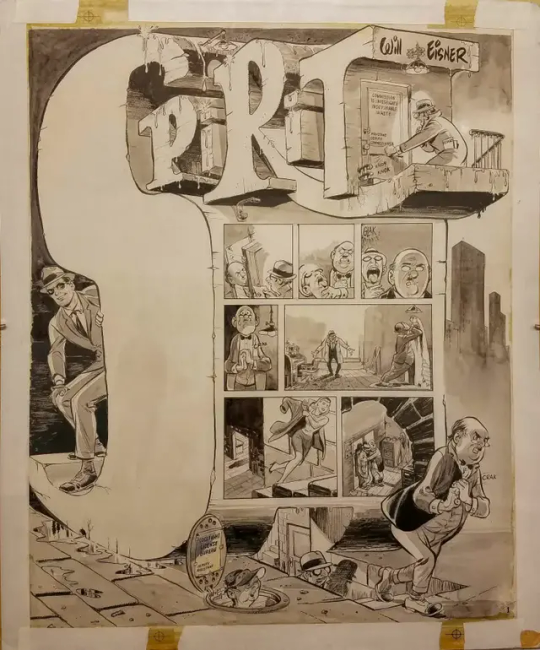
The Spirit
by Will Eisner and Chuck Kramer
26 notes
·
View notes
Text

#world news#time magazine#people magazine#mad magazine#architectural digest#new york times#chicago tribune#the sentinel#elle magazine#sixteen journal#life magazine#national geographic#washington post#the new yorker#new york#sports illustrated#newsweek#scientific american#womans world#woman's day#advocate men#workout#fitness#gq style#gq magazine#the herald#american zionist#road and track#off road#cbc news
1 note
·
View note
Text
Saturday, August 18, 1956: Elvis at the Knickerbocker Hotel in Hollywood, by photographer Ed Braslaff


The "Rooftop Glamour" photo shoot 🥹
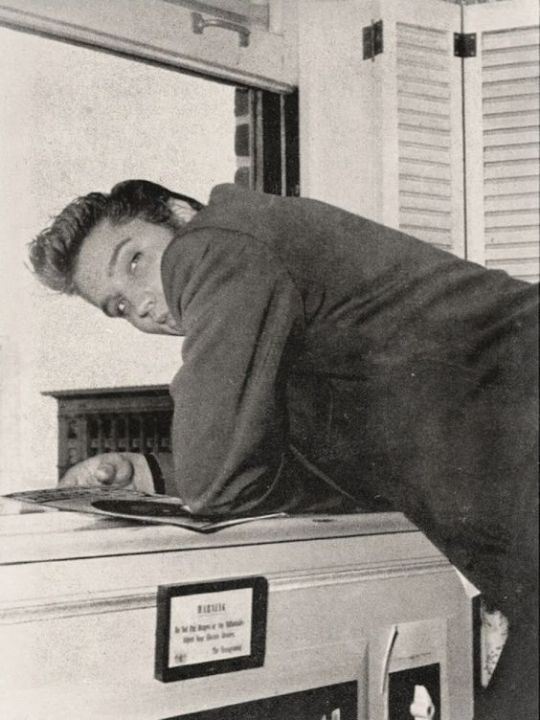

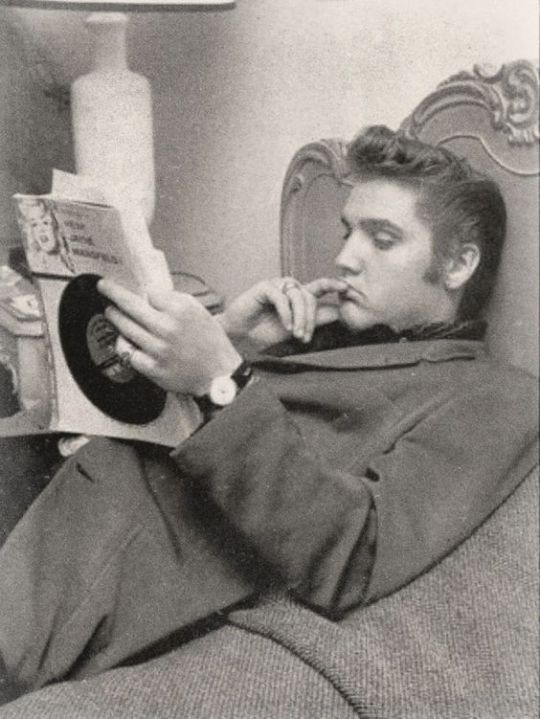
MARTY LACKER
"On those first two movies, Elvis stayed at the Hollywood Knickerbocker, on Ivar Avenue. His parents went, too. Elvis rented the whole eleventh floor. He'd sit up there and write his name in lighter fluid on the glass-top coffee table, and then set it on fire, watch it blaze. Girls remember stuff like that. Then, for "Loving You", he moved to the Beverly Wilshire. That was his home in Hollywood until he started renting houses in the sixties."
— As told on "Elvis Aaron Presley: Revelations from the Memphis Mafia" by Alanna Nash
Principal filming on "The Reno Brothers" (original title for "Love Me Tender" movie) began August 22, in Hollywood, and finished up on September 21, 1956. This photo shoot happened on the weekend right before the first week of filming Elvis' first movie could begin. Imagine how he was feeling! Yet, he looked so natural in all pictures. Not a sign on anxiety can be seen through his pictures.
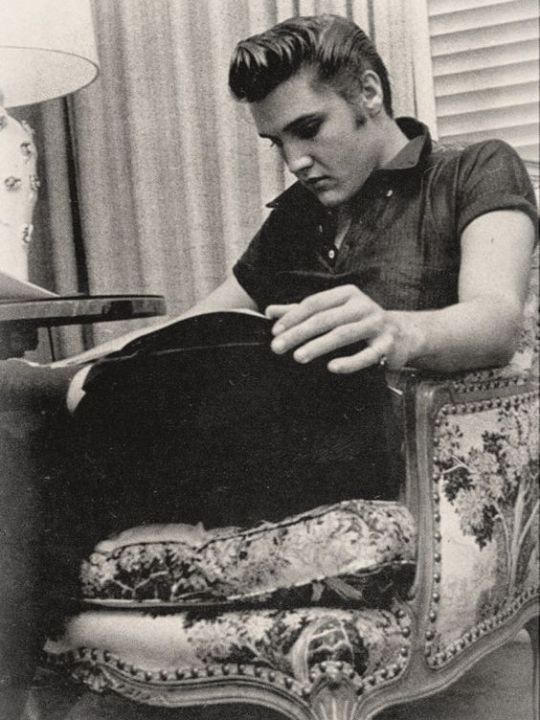
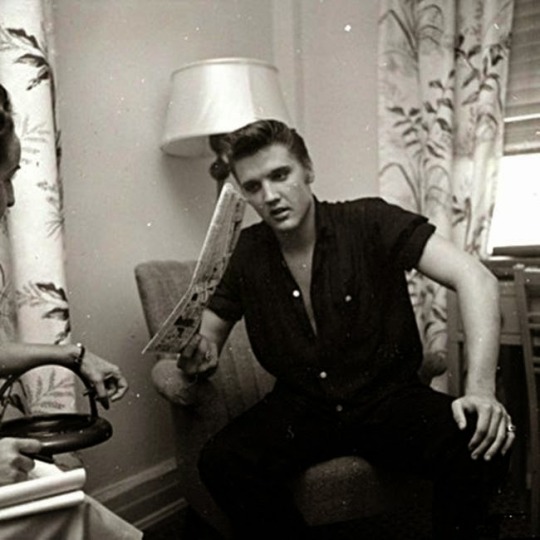
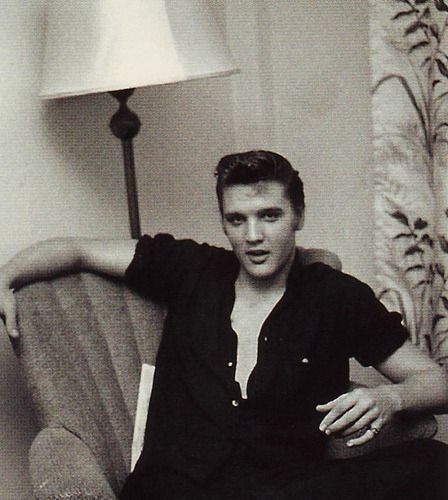

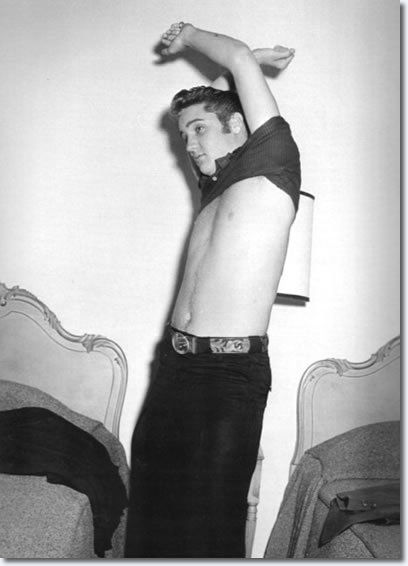

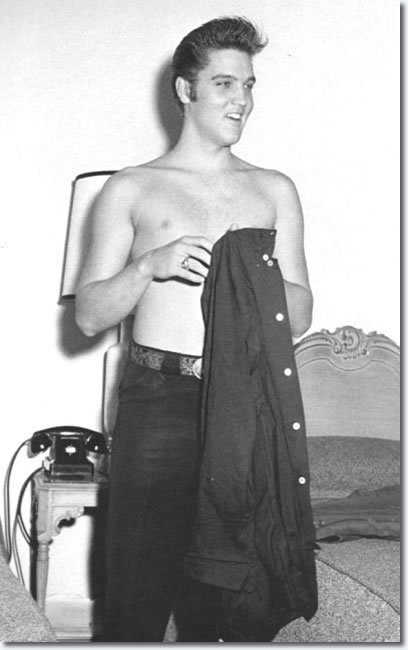
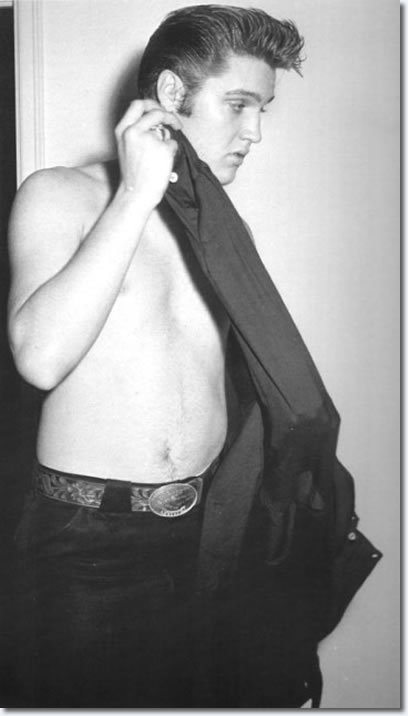
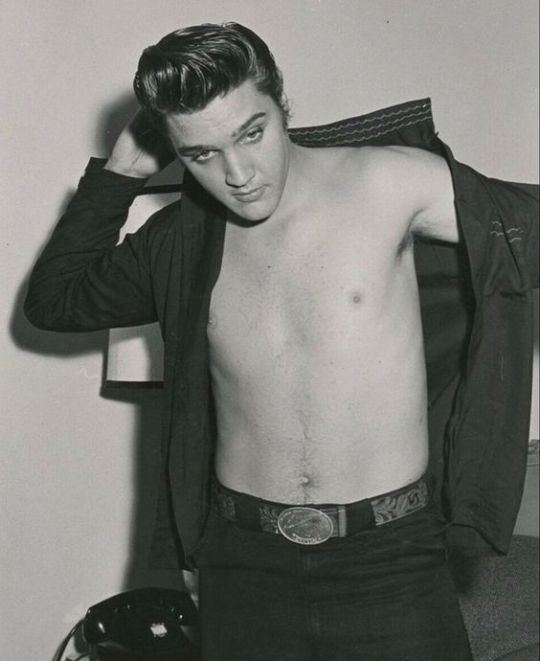
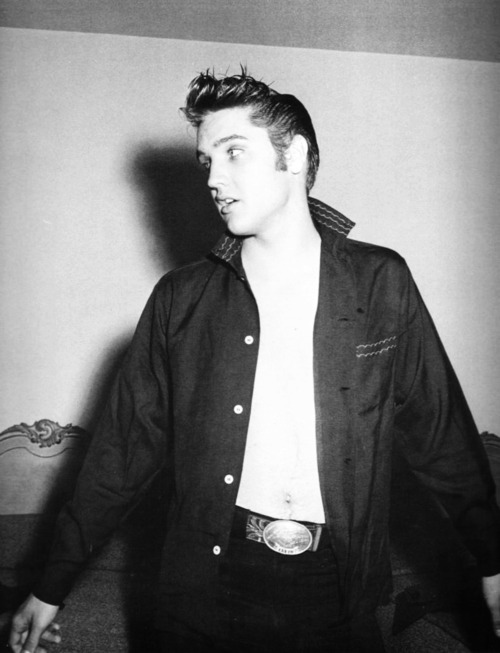
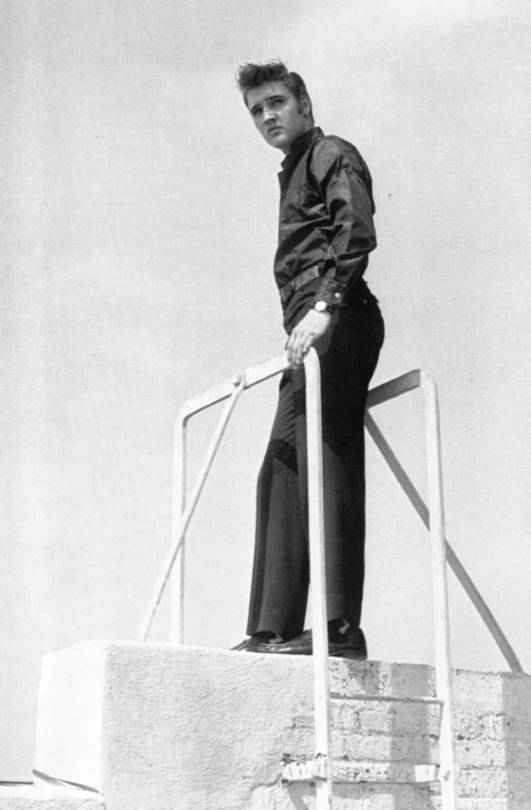
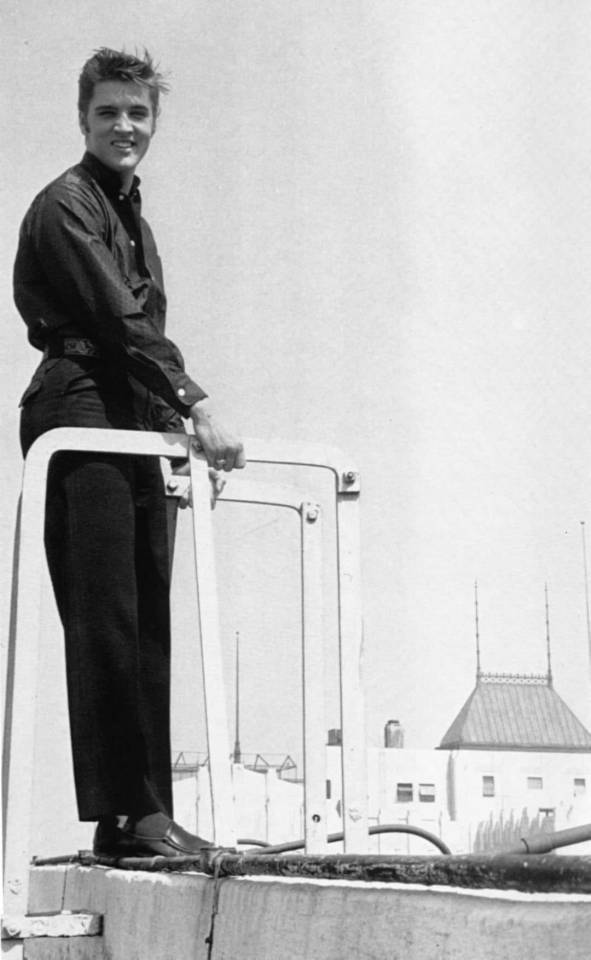
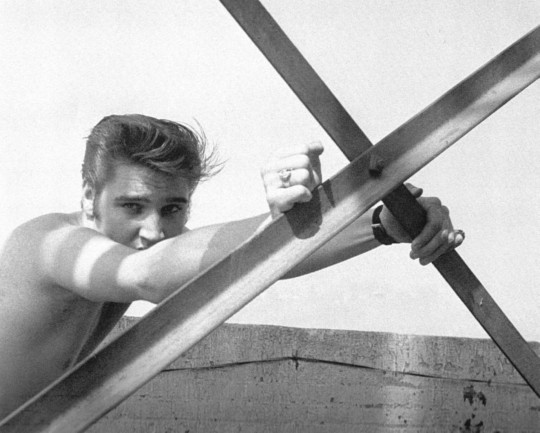
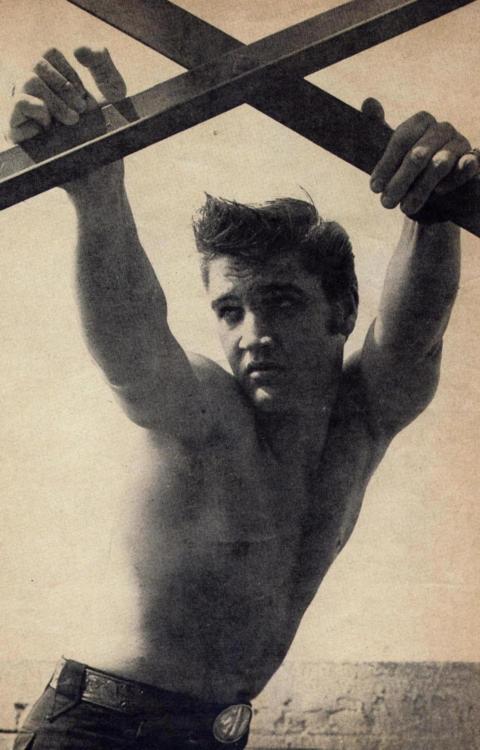
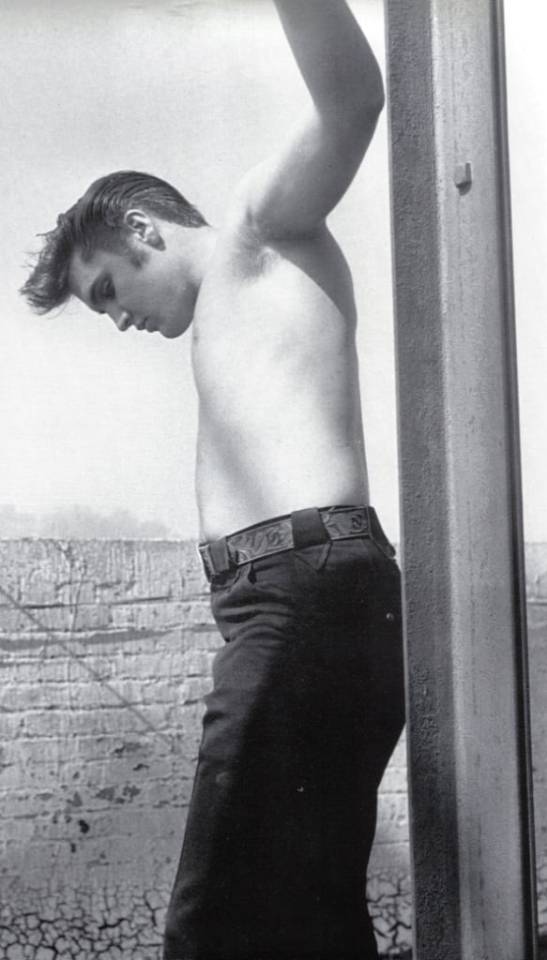

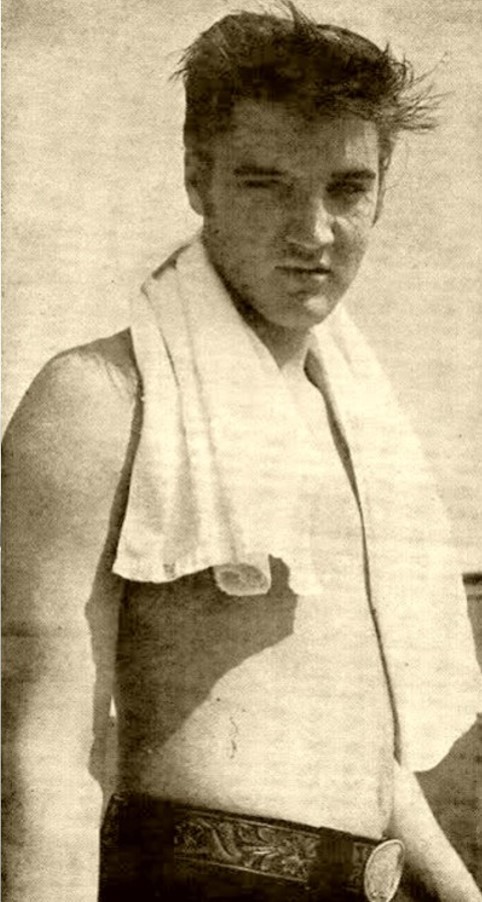
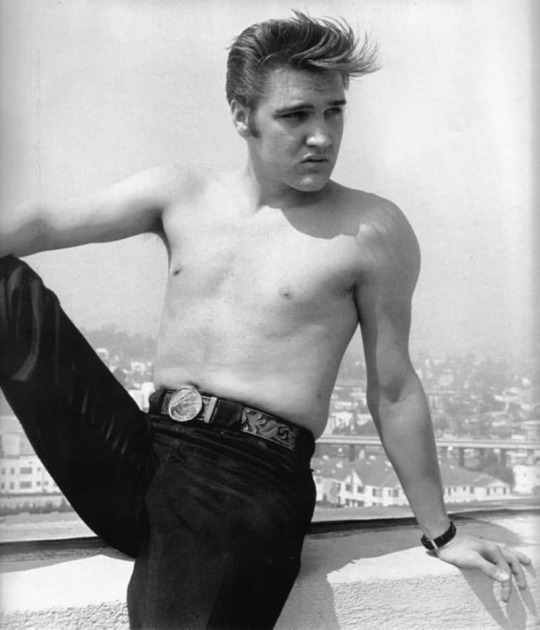

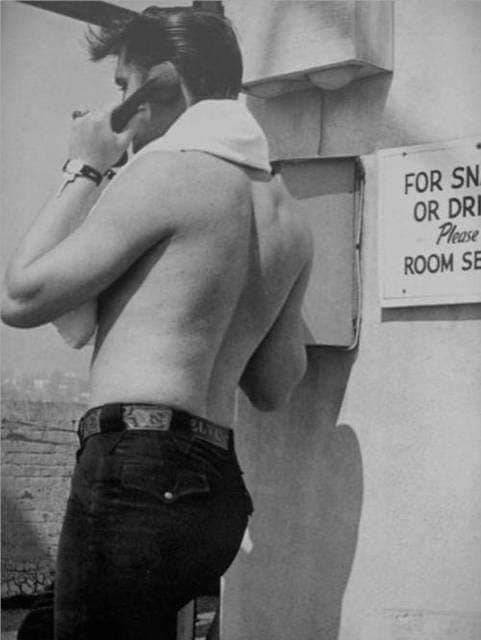
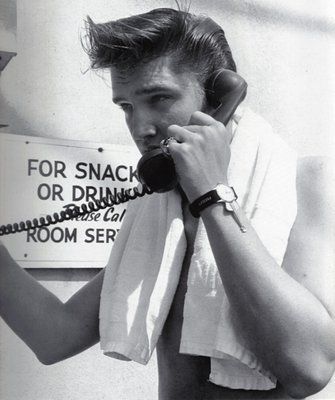
Once the filming of "Love Me Tender" had begun, Reporter Patricia Vernon (from The New York Herald Tribune) was sent to interview Elvis on the set.
Patricia asked Elvis if he thought he was a Sex Symbol to kids, as some psychiatrist said at the time.
Elvis: "Someone should put those psychos on a long couch and tell them a thing or two," he said. "They all think Ah'm a sex maniac. they're just frustrated old types, anyway. Ah'm just natural."
On the interview moment, Patricia shared:
He gave me the heavy-lidded look again. "You don't love me," he said accusingly. I told him I didn't love anyone on such short notice.
"Ah bet you'd like me if Ah tried," he said. "Ah'm just teasin' now, but Ah'd be sweet and you'd like me because Ah was sweet, wouldn't you?" (If I was her: 🫠)
He was teasing, but underneath I sensed the desire of a small boy seeking approval.
Then he went out to meet two young fans who wanted their picture taken with him. He told me to stay where I was, that he'd be right back.
"I RAN FOR MY LIFE."
Excerpt from the 1956 All Elvis Magazine "HERO or HEEL"
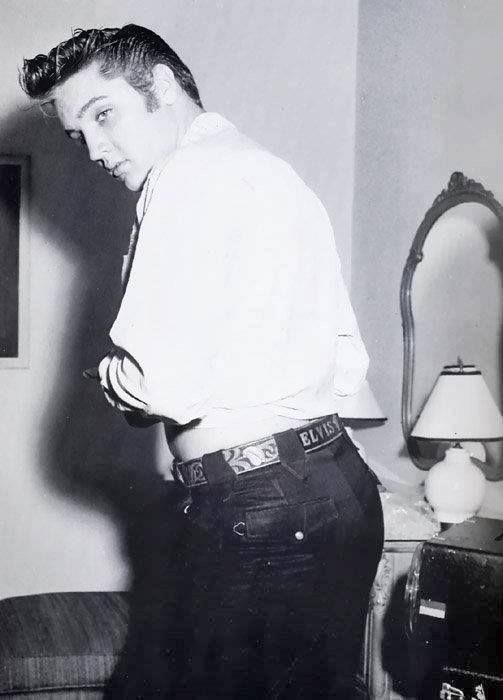
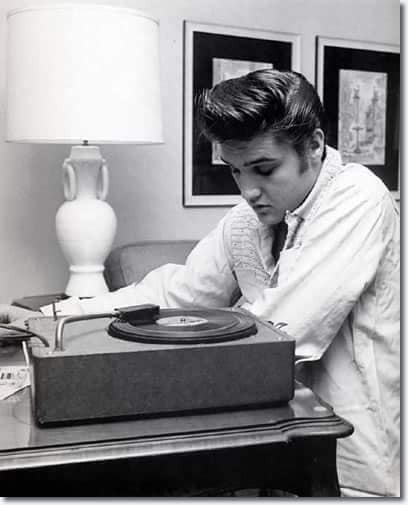
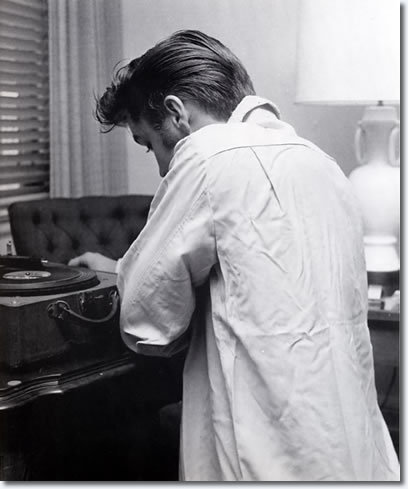
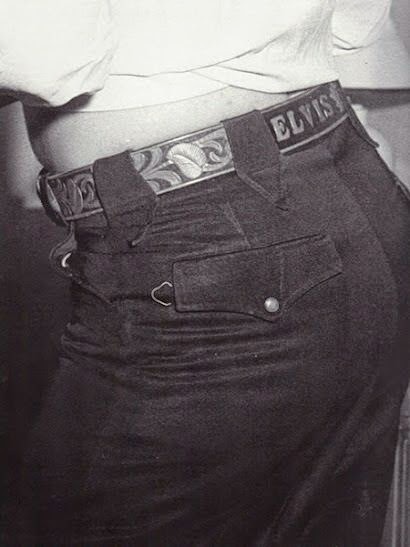
That photo shoot is beyond amazing. Elvis was so natural in front of a camera right from the very start of his career, it's incredible. He totally was born to be an public figure. There's a few more wonderful pictures on this day, but only 30 is allowed here (what a shame). Side note: The last photo is merely for historical purposes. 🫠
#i'd like to be a fly on the wall that day#Ed Braslaff#elvis photographs#elvis photos#elvis history#elvis photographers#50s elvis#elvis presley#elvis the king#elvis fans#elvis fandom#as a photographer myself I always imagine what a deep feeling of achievement photographing Elvis must have given them#not only Elvis but any historical figure or important moment in history
31 notes
·
View notes
Text
‘An Emotional Lightning Rod’: Jeff Buckley’s ‘Grace’ at 25
Jim Shahen
POSTED ON AUGUST 22, 2019

Grace is 25 years old. Jeff Buckley’s debut is gorgeous and heartbreaking, ambitious, daring and eclectic, and, as the sole studio album released during his short life, the only fully realized vision of the artistic brilliance he possessed.
With the expectation that his first LP was the starting point of an iconic recording career, Columbia Records released Grace on Aug. 23, 1994. Entertainment Weekly deemed it “stunningly original” and “too good to be true.” Greg Kot of the Chicago Tribune heralded Buckley’s voice as having “a soulful intensity that sends chills.” Peers and legends such as Jimmy Page and Robert Plant, Paul McCartney, Bob Dylan, David Bowie, and Chris Cornell were effusive in their praise of the album and of Buckley’s tremendous gifts as a singer, guitarist, and composer.
Others were not so kind. Rolling Stone lauded his ambition, but gave Grace a three-star review that featured the one of the poorest-aging opinions in the magazine’s history: “The young Buckley’s vocals don’t always stand up: He doesn’t sound battered or desperate enough to carry off Leonard Cohen’s ‘Hallelujah.’” And Robert Christgau, the “Dean of American Rock Critics,” gave it a C rating and lampooned the hoopla surrounding Buckley by writing, “Let us pray the force of hype blows him all the way to Uranus.”
But those less-than-stellar reviews engaged with Grace on the same terms as the glowing ones — that this was the starting point for an artist with sky-high expectations, talent, and potential. Buckley’s horrific drowning death at age 30 in the Wolf River, an offshoot of the Mississippi, in 1997 ensured it was also his end point. But between his own passing and the passage of time, Grace has only grown in stature.
In 2014, the Library of Congress added Buckley’s “Hallelujah” to the National Recording Registry. Rolling Stone, walking back its prior opinion, ranked the track 259th in its 500 best songs of all time in 2003 and put Grace at 303 in its top 500 albums list the same year. Over the past decade, essentially every music publication of note has included Grace on its list of both top releases of the 1990s and overall albums.
youtube
A Vessel
The son of prodigiously talented folk-jazz singer/cult icon Tim Buckley and Mary Guibert, Jeff arrived at music without the guidance of the father he met only once before Tim’s death in 1975 from a drug overdose. While a cornerstone of his legacy is his gorgeous, multi-octave voice, Buckley’s first passion and pursuit in music was the guitar, where he was drawn to the sounds of Led Zeppelin and jazz fusion.
After spending the latter half of the 1980s kicking around as a guitarist in various jazz, metal, punk, funk, reggae, and R&B bands, Buckley began to pursue his own songs. In 1991 he attracted industry attention when, accompanied by guitarist Gary Lucas, he made his public singing debut at a tribute show for his father.
Photo by Merri Cyr / Sony Music
From there, Buckley’s career trajectory changed. After collaborating with Lucas for a year, he went out on his own and became part of the New York City café scene. These shows, later documented on Live at Sin-é, became part of his legend, featuring both his original tunes and an eclectic mix of fare made popular by Nina Simone, Billie Holiday, Judy Garland, and Bad Brains.
These café shows regularly attracted record executives and power players, and in October 1992 Buckley signed a three-album deal with Columbia Records. The label had high hopes that Buckley’s brilliance would quickly reveal itself to a wider range of fans. The thinking was that he’d succeed labelmates Bob Dylan and Bruce Springsteen as someone who would flourish into the finest singer-songwriter of his generation and compile a legendary body of work.
For the band that helped record Grace and toured with him in support, that brilliance was apparent from the beginning.
“This might sound stupid, but I don’t give a shit,” his former drummer Matt Johnson says. “But one time when we were playing, something about his voice went through my body. It was an entirely metaphysical moment where something supernatural happened.
“The man was one of the most extraordinary musicians to ever live,” he adds. “Jeff was this lightning rod of the tone and tenor of all the human emotion in a room. He had this ability to act as an emotional lightning rod, and I always thought he’d hopefully become a vessel for that.”
Saving ‘Grace’
Johnson first met Buckley in summer 1993 and within a couple of months was recruited to be the drummer for the Grace recording sessions. Though the then-23-year-old had had some session and recording experience, Johnson had never worked on a project of this scale before. As he looks back on the experience, Johnson thinks his youth and relative inexperience played a large part in why Buckley wanted him in the band.
“Jeff seemed to be confident he could get what he needed from this ensemble,” he says. “We were young and, in my case, had a lot of insecurities. I think he wanted that — he didn’t want session musicians, he wanted the transformation younger players would bring and create a snapshot of that.”
Photo by Merri Cyr / Sony Music
While Johnson recalls that “the stakes felt high” and there was a “sense of importance of Jeff” to Columbia, he doesn’t remember the process of creating Grace as particularly laborious or fraught. Part of this can be attributed to the calming nature of producer Andy Wallace, who had previously worked on Nirvana’s Nevermind, Run-DMC’s Raising Hell, and multiple albums by Slayer, and his ability to nurture the creative process.
Johnson also attributes a large part of that to Buckley’s multi-instrumental capabilities, uncanny ear, instincts, and efficiency. Because of that, it only took about a day per song to lay down the non-vocal elements.
“I thought he was a very good collaborator, bandleader, and mentor,” Johnson says. “Jeff understood how to both be an individual musician, while also still keenly aware of how to be part of an ensemble.
“His listening was a very powerful thing to be present for,” Johnson continues, comparing Buckley’s auditory capacity to that of composer Johann Sebastian Bach. “It could be textures, entry points, Jeff just knew how stuff should be held together. He could get a pairing of two basic opposites and it’d sound idiosyncratic and perfect.”
While Johnson was there for the entirety of the recording process, Michael Tighe came into Buckley’s band at the tail end of the sessions. The guitarist had met Buckley through a mutual friend in high school and the two had jammed on and off. As Buckley closed in on completing Grace and was putting together his touring band, he reached out to his friend.
Much like Johnson, Tighe was impressed by Buckley’s ability to absorb so many influences and styles, then translate it into his own work.
“He would ruminate on the music a lot and when it came time for recording, he’d really focus,” Tighe says. “He’d usually come in very quickly or he’d obsess on it and get into a perfectionist mindset. But he wouldn’t release something until it was perfect.
Photo by Merri Cyr / Sony Music
“He was really taken with a lot of music,” Tighe says. “He could cast this spell and create a space that was quite meditative. We would sit or stand in a circle and drone on something. We all had very good chemistry; it’s why he put the band together.”
That natural chemistry Buckley had with Tighe and the rest of the group came in handy and allowed Tighe to come in with a late contribution that changed the complexion of Grace.
“One day I played him the chords to ‘So Real.’ It was something I played him in my room (back in high school),” he recalls. “This was after, like, most of the album was done. During rehearsals he said, ‘Hey, remember that song you played in your room?’”
Thus, “So Real” came to be. To make room for it on Grace, Buckley bumped “Forget Her” off the album. This move came much to the chagrin of Columbia Records, which had planned to issue “Forget Her” as the lead single. Neither Johnson nor Tighe can recall quite why Buckley held such disdain for “Forget Her,” a tune of his own composition, but both vividly remember his adamance in replacing it.
“‘So Real’ saved the record for him,” Johnson says. “And it points toward the sound he was going for, it’s the sound of a door opening to the future.”
youtube
A Cult Hero
When Grace was finally released, grunge rock, hip-hop, and The Lion King soundtrack dominated the charts. There weren’t many acts out there simultaneously channeling Nina Simone, Nusrat Fateh Ali Khan, the Smiths, and Led Zeppelin. As such, it took a long time for the record to take hold and capture the imagination of listeners: It peaked at 149 on the Billboard Top 200 albums chart that year and didn’t reaching platinum-selling status until 2006.
Photo by Merri Cyr / Sony Music
Even without immediate success, the participants knew they had made something special.
“You can go back now and think about the production and the mix from that time period, but I think it’s perfect in its own way,” Tighe notes. “I think Jeff was very aware of how good the album was, but I think it bothered him slightly the album wasn’t more successful. But he was already a cult hero. We all thought it’d be a longer career and that would change.
“The zeitgeist was so different back then. There weren’t bands like Coldplay, Radiohead had just started,” Tighe says. “When I play it now for people, I love watching the glaze that comes over their eyes. Ultimately, it’s his voice, people just have an immediate emotional reaction to his voice.”
Johnson’s feelings on Grace are tied strongly to the recording sessions, that moment in time they captured and what it all meant personally. The fact that it connected with people well after the fact is an added bonus.
“When it comes to Grace, I feel very, very lucky. I’m never in a position to look at it like anything but a fuckin’ penny from heaven,” he says. “There isn’t one song I don’t like. When I hear it, it’s like I made this amazing best image of me that could be captured in any scenario.
“I can’t find fault with it and it’s not like I haven’t heard criticism,” Johnson continues. “But the feeling I got recording it was absolutely spine-chilling. I did not ever more feel what the drive of my life was, and it could not have borne better fruits. To have Rolling Stone or whoever now praise it is icing on the fucking cake. I don’t ever feel like, ‘What the fuck took you so long?’”
Musical Echoes
It took a few years for Buckley’s influence on fellow artists to be heard. By Tighe’s estimation, it was around the early 2000s that he started hearing Buckley-esque melodies on the radio, including from bands such as Coldplay and Radiohead, who drew inspiration from Buckley’s chord progressions and structures.
“Now you just hear it all the time,” he says. “There was that moment a while back someone did ‘Hallelujah’ on one of those shows like American Idol. The zeitgeist has changed a lot.”
Of course, Buckley’s legacy is more than just the alt-rock waves of decades past and singing competitions designed to highlight vocal chops. There’s a new breed of singer-songwriters that have used Grace as a starting point for their endeavors.
Madison Cunningham (photo by Claire Marie Vogel)
Madison Cunningham is a 22-year-old musician who just released the LP Who Are You Now and cites Buckley as one of her heroes. On songs like “Something to Believe In” and “Last Boat to Freedom,” you can hear her use that admiration to create her own artistic statement.
She was gifted a copy of Grace from a friend as a teenager and at first she didn’t dig it. But once she revisited it a few months later, it was a revelation.
“I didn’t get it and I really wanted to get it, but it was a big palette stretch for me,” Cunningham recalls. “But once I did, it was like, ‘Whoa, I get it! This is like the song that’s inside my head!’
“Always his voice stands out. Still to this day I haven’t heard a voice like that,” she continues. “There was such a depth to his work, you’ve got to sit a minute to think about it all.”
While Buckley’s vocal range and power moved and inspired her, what’s seeped into Cunningham’s work was the way he played guitar and arranged his material to incorporate all the different sounds that moved him.
“He changed how I played guitar,” she says. “He was so bold with his chord progressions. There’s certain chords he played that are just very unique to him. Even now when I play something, I’m like, ‘Oh, those are Buckley chords.’
“There’s just something special to him,” Cunningham adds. “He had his own genre and sound and was very unashamedly himself. That’s very hard to find.”
Cunningham identifies why, 25 years later, Grace and Jeff Buckley are still relevant parts of the cultural landscape. It’s why there’s interest in the various bootlegs, live takes, demos, and the recent biographical graphic novel his estate has released in the past two decades.
The latest batch of such releases, timed for the anniversary, includes four concert albums as well as expanded digital versions of Grace (including “Forget Her”), Mystery White Boy (a full-length live album), and Sketches for My Sweetheart the Drunk, an album of material Buckley recorded in 1996 and 1997 and was first released a year after his death. All will be available digitally on Aug. 23.
In the years since Buckley’s tragic demise, both Tighe and Johnson have gone on to work on other major projects. Tighe’s written for and worked with Adele, Mark Ronson, and Liam Gallagher. Johnson has played with Rufus Wainwright and Jade Bird and had a five-year stint with St. Vincent.
Both men are active, talented, and in-demand career musicians. Neither needs to relive their time with Buckley as a way to boost themselves. But both are enthusiastic in discussing their friend and his gifts, and are doing their part to ensure people remember him.
“As a special talent, he was pretty ineffable,” Tighe says. “He was attracted to music with spirituality and he could embody that. It wasn’t something he learned, it was just given. He was incredible.”
“With Jeff, because he died in such an unforeseen way, I try to make the time to talk about him,” Johnson says. “Jeff had a certain intelligence and this explosion of emotion that was a soaring, insightful, penetrating whole vision of a man. I’ll always do what I can to honor that.”
To commemorate the 25th anniversary of Grace, Columbia/Legacy has shared a previously unreleased live video of “Lover, You Should Have Come Over,” filmed during a concert in Cambridge, Massachusetts, on Feb. 19, 1994.
#jeff buckley#jeffbuckley#‘An Emotional Lightning Rod’: Jeff Buckley’s ‘Grace’ at 25#jim shahen#the journal of roots and music#no depression#Youtube
7 notes
·
View notes
Text

Erika Mann and Annemarie Schwarzenbach, around 1930/31
Annemarie Schwarzenberg was a Swiss journalist, writer, photographer and world traveller. In the early 1930s she had a brief affaire with Erika Mann.
Erika Julia Hedwig Mann (9 November 1905 – 27 August 1969) was a German actress and writer.
During World War II, Mann worked as a journalist in London, making radio broadcasts, in German, for the BBC throughout the Blitz and the Battle of Britain. After D-Day, she became a war correspondent attached to the Allied forces advancing across Europe. Via W

Female war correspondents during World War II.jpg. (Left to right):
Ruth Cowan, Associated Press
Sonia Tomara, New York Herald Tribune
Rosette Hargrove, Newspaper Enterprise Association
Betty Knox, London Evening Standard
Iris Carpenter, Boston Globe
Erika Mann, Liberty magazine. Via W
5 notes
·
View notes
Text
LUCY & THE WRITERS!
The Wordsmiths of the Lucyverse

Whether Lucy was the writer, or one of the various characters in her universe, the creative output always made us laugh! Novelists, playwrights, screenwriters, journalists, composers, and columnists were all part of the Lucyverse.
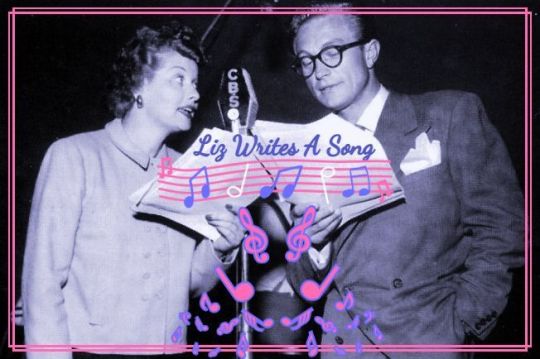
"Liz Writes a Song” (1949)
Liz Cooper (Lucille Ball) is convinced that she is a musical talent, but when a music professor (Hans Conried) tells her she'll never be a singer, she decides to take up songwriting instead!
LIZ: “Carrie Jacobs Cooper writes again!”
Carrie Jacobs-Bond (1862-1946) was a songwriter who composed some 175 pieces of popular music from the 1890s through the early 1940s. She is perhaps best remembered for writing the parlor song "I Love You Truly", becoming the first woman to sell one million copies of a song.

“Lucy Writes a Play” (1952)
Lucy writes a play set in Cuba for Ricky to star in, but he refuses the part. She changes her play from Cuba to England and has Fred take Ricky's spot. Once Ricky learns a famous producer will be in the audience, he decides to surprise Lucy and appear in the play, but he has the wrong script.
Ricky sarcastically calls Lucy “Mrs. Shakespeare.” Her first play is titled “A Tree Grows in Havana” and the revised version is titled “The Perils of Pamela”.
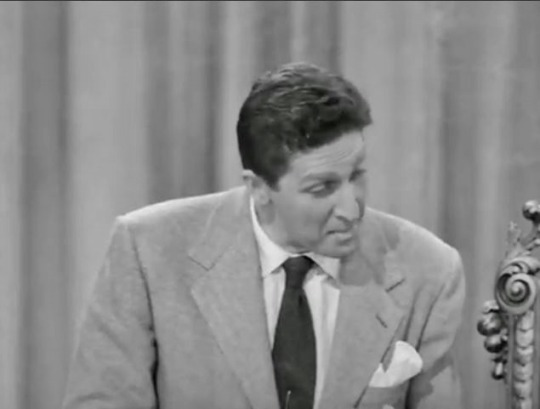
“The Publicity Agent” (1952)
Peter Leeds plays the newspaper reporter who asks the Scheherazade,
Maharincess of Franistan.
LEEDS: “Would Her Highness answer a few questions for the press?”
LUCY: “Yes.”
LEEDS: “Good. Your highness, is it true that Ricky Ricardo is your favorite vocalist?”
LUCY: “Yes.”
LEEDS: “Do you like any other American performers?”
LUCY: “No.”
LEEDS: “Now, let me see if I have this straight... You've never seen Ricky Ricardo in person, you first heard his records two years ago and you fell in love with his voice and decided to come to America to see him. Your father didn't approve, but you came anyway and you can hardly wait to hear him sing. Is that right?”
LUCY: “Yes, no, yes, yes, yes, no and yes.”
LEEDS: “I see. Now about the political situation in Franistan ---”

“The Operetta” (1952)
The Wednesday Afternoon Fine Arts League is putting on an operetta and Lucy decides to write the show herself! Needless to say, Ricky and the Mertzes are in the cast as well. The final script is “The Pleasant Peasant” by Ethel 'Romberg' and Lucy 'Friml' and starring 'John Charles' Ricardo. In reality, the songs were written by series composer Eliot Daniel, who wrote the show's theme song.
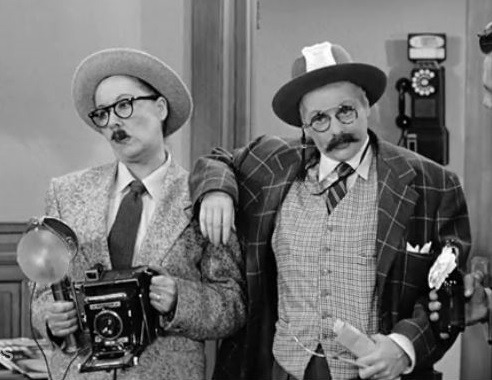
“Ricky Has Labor Pains” (1953)
To crash Ricky’s ‘daddy shower’ (aka stag party), Lucy and Ethel disguise themselves as Sam and Fred, reporters for the New York Herald Times Tribune, a mash-up of several real New York dailies.

“Lucy Writes a Novel” (1954)
Hearing that a housewife got $10,000 for writing a book, Lucy decides to become a novelist. Much to the chagrin of Ricky, Fred and Ethel, her subject will be a thinly disguised (and outrageously romanticized) version of her own life titled “Real Gone With The Wind”.


LUCY: “You'll get no more books from me, so go watch television!”

“Fan Magazine Interview” (1954)
Magazine journalist Eleanor Harris doing a feature story on the Ricardo marriage, at the same time that Ricky's agent concocts a publicity scheme inviting women on the Tropicana mailing list to a phony date.

Eleanor Harris (played by Joan Banks) was the name of a real magazine writer who wrote about Lucy and Desi as early as 1940. She also authored a book titled The Real Story of Lucille Ball published about the same time this episode was first aired.

“Ethel’s Hometown” (1955)
The last stop before Hollywood is Albuquerque, New Mexico, Ethel’s hometown, where she is given the star treatment instead of Ricky. Billy Hackett (Chick Chandler), editor of the Chronicle, is doing a story on Ethel Mae to herald her return on her way to Hollywood.
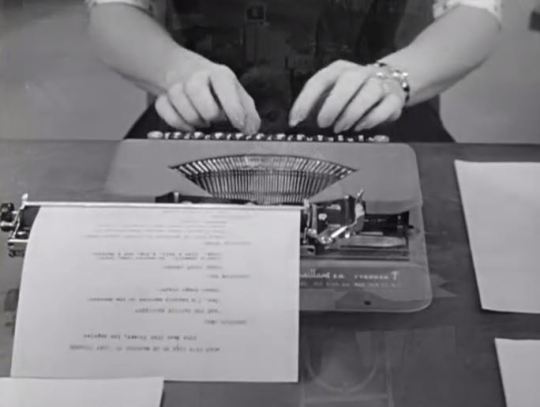
“Bullfight Dance” (1955)
Lucy is asked to write an article for Photoplay Magazine about what it’s like to be married to Ricky. Lucy keeps the contents of the article secret until she’s given a plum role in his latest show.

“The Hedda Hopper Story” (1955) / “Lucy Takes a Cruise to Havana” (1957)
Both episodes featured Elda Furry, a film actress who turned gossip columnist and renamed herself Hedda Hopper (1985-1966). She was the go-to source for what was going on in the personal and business relationships of Tinseltown.

She supported Lucy and Desi throughout their careers and they repaid them with these special appearance, as well as mentioning her name in several other episodes. Hopper was recognizable for her elaborate headgear.

“Homecoming” (1956)
Recently returned from Hollywood, Lucy is interviewed by gossip columnist Nancy Graham (played by Elvia Allman) about life as wife to a famous movie star (aka Ricky). The character is probably a tribute to Sheilah Graham, who was an English-born Hollywood journalist. Along with Louella Parsons and Hedda Hopper, Graham wielded sufficient power to make or break Hollywood careers – prompting her to to say that she was "the last of the unholy trio."

“Milton Berle Hides Out at the Ricardos” (1959)
Milton Berle appears here in the capacity of a published author, promoting his first (and only) novel, Earthquake written with John Roeburt.

Berle had previously written the joke books Laughingly Yours in 1938 and Out of My Trunk in 1948. He wrote his autobiography in 1974 with help from Haskel Frankel. His last book was a 1987 collection of sketches and reminiscences titled B.S. I Love You.

“Lucy Becomes a Reporter” (1963)
After just three days as the fill-in society reporter for the Danfield newspaper, Lucy’s job is hanging by a thread. The only thing that will save it is an interview with a press-shy financier visiting town.

Mr. Foley, the Tribune’s editor, refers to Lucy as Brenda Starr. Brenda Starr is the lead character in a comic strip about an adventurous female reporter. It debuted in 1940. Like Lucy, she had red hair. Lucy says that she was called ‘Clare Boothe Lucy’ in high school, a pun on Clare Boothe Luce (1903-87), who was a writer and journalist in her own right, in addition to being married to Henry Luce, a powerful publishing magnate in the magazine industry. Viv calls Lucy ‘Louella’ a reference to gossip columnist Louella Parsons. Lucy later invokes the name of Parsons’ chief rival, Hedda Hopper, another chronicler of Hollywood during the mid-twentieth century.

Critic’s Choice (1963)
Lucille Ball and Bob Hope play husband and wife theatre critics in the film based on the 1960 Broadway play of the same name written by Ira Levin.
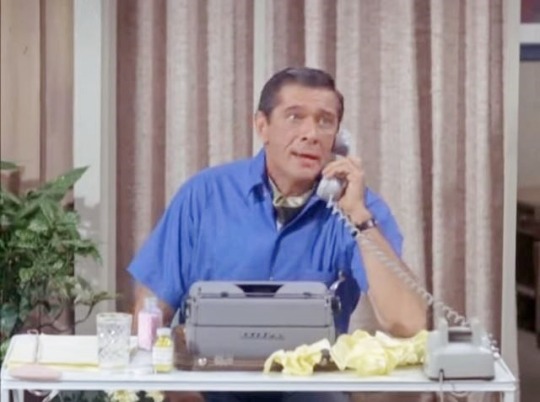
“Lucy and the Soap Opera” (1966)
Curious to find out how “Camden Cove,” her favorite soap opera, will turn out, Lucy disguises herself in a number of outrageous get-ups to gain access to the show’s reclusive writer Peter Shannon (Jan Murray). When her efforts fail, she gets herself cast as an extra for a taping of the soap.

“Lucy and Eva Gabor” (1968)
The author of a controversial novel (Eva Gabor) is in town and needs a quiet place to work so Harry volunteers Lucy's home. Naturally, it is anything but peaceful and far from quiet.
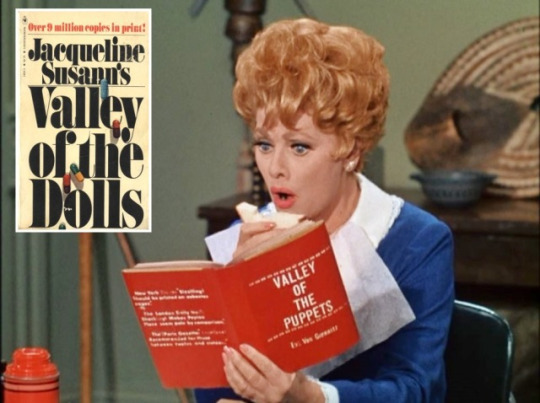
Eva Von Graunitz (Gabor) is writing a follow-up novel to her successful “Valley of the Puppets”, a title that parodies Jacqueline Susann’s Valley of the Dolls (1966).
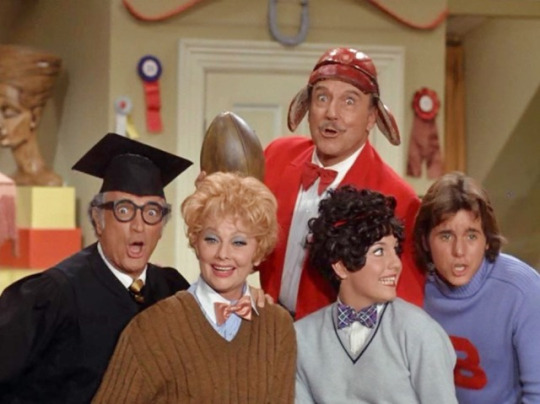
“Lucy the Co-Ed” (1970)
Harry's old flame Gloria (Marilyn Maxwell) is in town to help produce a musical for their college alumni. They resurrect a show Harry wrote in 1928 and cast Lucy, Kim, and Craig in supporting roles. It was written by Harry during his senior year there in 1928. Previous episodes have stated that Harry both performed and wrote shows while in college. The title of his musical is “It's Always Do-Wacka-Do at Bullwinkle U”!
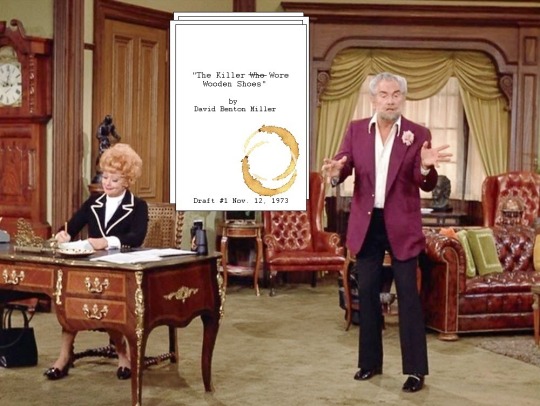
“Tipsy Through the Tulips” (1972)
Lucy is in charge of keeping a mystery novelist (Foster Brooks) sober long enough to finish his next book. The book David Benton Miller dictates to Lucy is titled “The Killer Wore Wodden Shoes,” a murder mystery set in Holland.
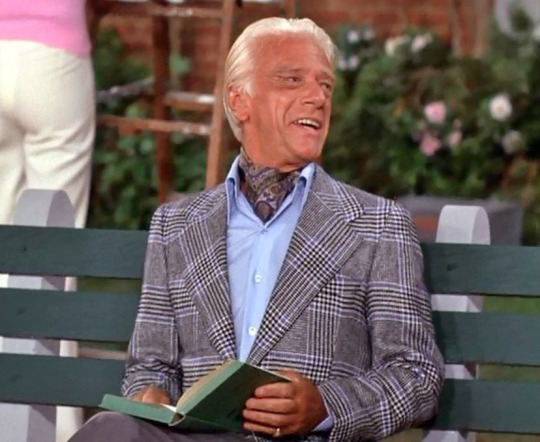
“Lucy and the Professor” (1973)
Lucy thinks Kim is interested in one of her college professors. She mistakenly believes it is Professor Dietrich (Murray Matheson), author of the best-selling book Sex and the College Girl. It is actually her much younger music professor John Kleindorf (John Davidson).

“Lucy Goes on Her Last Blind Date” (1973)
Lucy dates eccentric Ben (Don Knotts) who is a prize-winning writer of verses for greeting cards!
#Lucille Ball#I Love Lucy#Desi Arnaz#Vivian Vance#William Frawley#The Lucy Show#Don Knotts#Here's Lucy#Foster Brooks#TV#CBS#Gale Gordon#Lucie Arnaz#Desi Arnaz Jr.#Robert Alda#Eva Gabor#Peter Leeds#Jan Murray#Milton Berle#Hedda Hopper#Sheilah Graham#Elvia Allman#Murray Matheson#Richard Denning#My Favorite Husband
4 notes
·
View notes
Text
Dorothy Thompson Is the Most Famous Female Journalist You've Never Heard Of
She made a name for herself by speaking out against fascism abroad and at home. Then the fight got personal.
— January 11, 2024 | Kirstin Butler

A Full-Color Illustration Featuring Archival Images of Journalist Dorothy Thompson, a Typewriter, Marching Nazi Troops, and the Book "I Saw Hitler". Art by Colin Mahoney. Source photo of Dorothy Thomspon: National Archives and Records Administration
On the morning of August 25, 1934, the American journalist Dorothy Thompson was taking breakfast in her room at the Hotel Adlon in Berlin when she received a letter from the Gestapo. “In view of your numerous anti-German publications in the American press,” Thompson was informed, “the German authorities, for reasons of national self respect, are unable to extend to you a further right of hospitality.”
The Reich bore her a distinct animus. For years, she had been critical of fascist movements throughout Europe. After being granted an interview with Hitler in 1931, Thompson wrote an especially unflattering portrayal of the soon-to-be German chancellor. That long essay, which first ran in Cosmopolitan Magazine, was subsequently turned into a book called I Saw Hitler. “He is formless, almost faceless,” Thompson had written, “a man whose countenance is a caricature, a man whose framework seems cartilaginous, without bones. He is inconsequent and voluble, ill-poised, insecure. He is the very prototype of the Little Man.” In addition to that injurious portrait, Thompson had produced a series of articles for the Jewish Daily Bulletin deploring Hitler’s anti-semitic policies.
The Führer was reportedly threatened enough by her work to demand the creation of a “Dorothy Thompson Emergency Squad” to rush translations of her articles. Now, at the personal directive of Hitler himself, she was being expelled from the country, an unprecedented act against an American correspondent.
A cadre of foreign journalists sent Thompson off, colleagues from her years as Central European Bureau chief for the New York Evening Post and Philadelphia Public Ledger. (She had been the first-ever woman appointed to the position, which oversaw foreign coverage for both newspapers, a decade earlier.) “Nearly the entire corps of American and British correspondents went to the railway station to see her off and wish her good luck,” the New York Times reported, adding that Thompson was presented with an armful of American Beauty roses as a gesture of admiration.
Far from silencing her, the expulsion only increased Thompson’s influence. The Times featured the story of her ban on the newspaper’s front page, and eagerly ran her reflections about it the following day. “My offense was to think that Hitler is just an ordinary man,” she wrote. “That is a crime against the reigning cult in Germany, which says Mr. Hitler is a Messiah sent by God to save the German people—an old Jewish idea.” Thompson closed her column in the Times with the kind of bon mot that had already propelled her to public renown: “To question this mystic mission is so heinous that, if you are a German, you can be sent to jail. I, fortunately, am an American, so I merely was sent to Paris. Worse things can happen to one.”

Thompson in 1937. Getty Images.
Upon her return to the United States, Thompson turned her indomitable energies toward denouncing fascism with every opportunity she was offered, and she was offered many. First came a 30-city lecture tour spanning the next year and a half. Then in 1935, NBC offered Thompson her own weekly radio show, allowing her to speak directly to tens of millions. The next year she began writing “On the Record,” a regular column with the New York Herald Tribune, that was syndicated to 150 other newspapers across the country, placing her opinions in front of millions more. She was eventually given a TIME magazine cover, where the accompanying profile called her and Eleanor Roosevelt “undoubtedly the most influential women in the U.S.”
Thompson leveraged all of these platforms to warn audiences about the dangers of totalitarianism—but not just in Europe. At home, she found cause for concern in the New Deal, with its wage- and price-setting, its massive public works projects and centralized power vested in the executive branch, all of which she feared could presage a slide into authoritarian rule. “What we are interested in is neither the dictatorial talents nor the dictatorial predilections of the President. We aren’t concerned with whether he wants too much power, but with whether he can get too much power.” In 1937, she testified before Congress about what she viewed as a slippery slope from consolidated federal control to fascism. “In country after country, under one slogan or another, the people are retreating from freedom,” Thompson told the Senate Judiciary Committee, “and voluntarily relinquishing liberty to force and authority.”
“Her point was this can happen anywhere,” University of London professor Sarah Churchwell told American Experience. “You have to strengthen your Democratic guardrails. You have to ensure that you don't let this happen to you because complacency is the enemy. And that is what she wrote about over and over and over again, banging the drum. Warning people, take this seriously. This isn’t a joke. And nobody is immune to it.” Thompson saw no conflict between her roles as a journalist and a staunch anti-fascist voice. “The function of journalism and a free press is not confined to the presentation of news,” she wrote. “Their function is to create continual debate, to provide a forum, to give opportunity for the expression of opinion.”

A promotional poster for the 1939 Bund rally in Madison Square Garden. Image courtesy of the National Museum of American Jewish Military History.
When it came to homegrown American Nazism, that expression involved significant personal risk. Thompson’s moment of direct action took place on February 20, 1939 at New York City’s Madison Square Garden. She was on her way to give a speech when she decided to join a convocation of 22,000 American Nazis hosted by the German American Bund, a pro-fascist organization with chapters across the country. The event had been planned to coincide with George Washington’s birthday, billed by the Bund as a “mass demonstration for true Americanism.”
Coverage in The Boston Globe the next day noted that the rally had “all the trappings of the spectacular mass assemblies familiar to Nazi Germany…Storm troopers strode the aisles. Military bands blared martial airs and German folk songs. Young and old Bund members paraded and drilled in the glare of blue spotlights. Arms snapped out in the Nazi salute.” The American flag hung side by side with the Nazi swastika and banners bearing messages such as “Stop Jewish Domination of Christian America.”
Thompson was seated in the front row of the press box, and during the evening’s speeches, began to laugh, loudly and disruptively. After being escorted out of the building by New York City police, she returned to her seat where she was surrounded by a dozen Bund stormtroopers. Thompson then proceeded to cause a second scene by shouting “bunk!” at the stage. “It may have been her finest moment,” wrote her biographer Peter Kurth, “the indelible dramatization of her promise to Hitler that she would not be muzzled by thugs.”
“I was amazed to see a duplicate of what I saw seven years ago in Germany,” she told a reporter after leaving the event. “Tonight I listened to words taken out of the mouth of Adolf Hitler.” It was precisely those words’ utterance at home that alarmed her most. She had spent a good part of her career watching how fascism could, improbable as it might first have seemed, sweep over a nation.
“No people ever recognize their dictator in advance,” Thompson wrote in a 1937 “On the Record” column, making the clearest case possible for constant vigilance. “He never stands for election on the platform of dictatorship. He always represents himself as the instrument for expressing the Incorporated National Will. When Americans think of dictators they always think of some foreign model. If anyone turned up here in a fur hat, boots and a grim look he would be recognized and shunned…But when our dictator turns up you can depend on it that he will be one of the boys, and he will stand for everything traditionally American.”
#Nazi Town | USA 🇺🇸#Article#NOVA | PBS#Dorothy Thompson#Most Famous#Female Journalist#Kirstin Butler#American Experience
0 notes
Text
Two Fillipino Writers

PONCIANO PINEDA
Ponciano Pineda was born on December 6, 1894, in Cabanatuan, Nueva Ecija, Philippines. He was the son of a prominent lawyer and a schoolteacher. Pineda received his early education in Cabanatuan and later enrolled at the University of the Philippines, where he studied English and education.
He became a teacher and worked at various schools in Manila.In 1926, Pineda won a scholarship to study at Columbia University in New York, where he earned a master's degree in journalism. While in the United States, Pineda worked as a correspondent for several newspapers and magazines, including the New York Herald Tribune and the Philippine Free Press.
Pineda's literary career began in the 1920s when he started writing short stories and essays. His first published work was an essay titled "The Philippine Problem and Its Solution," which appeared in the Philippine Free Press in 1924. Pineda's most famous work is the novel "Mabuhay!", which was published in 1930. The novel is at critique of colonialism and imperialism, and it reflects Pineda's belief in the importance of national pride and cultural identity.
In addition to "Mabuhay!", Pineda also wrote several other novels, including "The Great Malayan" (1935), "The Three Natives" (1936), and "The Other Side of the Moon" (1947). He also wrote numerous essays and short stories, which were published in various magazines and newspapers. Dinora was one of the leading writore 1960 for his contributions to Filipino literature.
ANICETO SILVESTRE
(No pic)
Aniceto Silvestre was born in April 17, 1901 in Santo Tomas La Union, Philippines. He grew up in a family of farmers and received his early education in a small school in his hometown. He later enrolled at the University of the Philippines, where he studied English and literature.
Silvestre's literary career began in the 1920s when he started writing poetry. His first published work was a poem titled "The Hands of the Potter," which appeared in the Philippine Magazine in 1925. Silvestre's poetry was known for its simplicity and sincerity, and it reflected his love for nature and his appreciation for the Filipino way of life.
Silvestre's most famous work is the poetry collection "Lupang Tinubuan" (Native Land), which was published in 1941. The collection includes poems that reflect Silvestre's love for his homeland and his appreciation for the beauty of nature. The poems are written in both English and Tagalog, and they reflect Silvestre's belief in the importance of language in expressing the Filipino identity.In addition to poetry, Silvestre also wrote several plays and novels. His most famous play is "The Sea-God of Sulu" (1929), which was inspired by the legend of the sea god of the Sulu.
Aniceto Silvestre passed away on July 19, 1964, in Manila, Philippines. He was recognized as one of the foremost writers of his generation, and his works helped shape the development.
1 note
·
View note
Text
Tom Wolfe
Tom Wolfe und der amerikanische Chauvinismus
Tom Wolfe und der amerikanische Chauvinismus
Die amerikanische Überlegenheit war und ist in allen Belangen der Naturwissenschaft, Wirtschaft, Industrie, Politik, des Handels, der Medizin, Technik, des gesellschaftlichen Lebens, der sozialen Gerechtigkeit und natürlich des Militärwesens total und unzweifelhaft.
Selbst Europäer, die noch unter den Qualen eines verletzten Chauvinismus leiden, blicken ehrfurchtsvoll auf das glänzende Beispiel, das die Vereinigten Staaten von Amerika der Welt gaben und geben. (Tom Wolfe)
Chauvinismus ist der Glaube an die Überlegenheit der eigenen Gruppe. Chauvinismus im ursprünglichen Sinn ist ein häufig aggressiver Nationalismus, bei dem sich Angehörige einer Nation aufgrund ihrer Zugehörigkeit zu dieser gegenüber Menschen anderer Nationen überlegen fühlen und sie abwerten. (Wiki)
Tom Wolfe (* 2. März 1930 als Thomas Kennerly Wolfe Jr. in Richmond, Virginia; † 14. Mai 2018 in New York City) war ein US-amerikanischer Schriftsteller, Journalist, Kunst- und Architekturkritiker sowie Illustrator.
Wolfe war zunächst Pitcher beim Baseball und hatte schon während des Studiums begonnen, halbprofessionell zu spielen. Wolfe gab dann den Sport auf und folgte dem Beispiel seines Professors Fishwick und schrieb sich für das amerikanische Doktoratsstudium an der Yale University ein.
Im Laufe seiner Forschung interviewte Wolfe viele Schriftsteller. Nach dem Studium in Yale arbeitete er als Journalist, unter anderem für die New York Herald Tribune und deren Magazin New York sowie für die Washington Post.
Sein erstes Buch mit dem Titel »Das bonbonfarbene tangerinrot-gespritzte Stromlinienbaby« war eine Sammlung verschiedener Reportagen unter anderem über Popmusik und Autobastler. Das 1965 erschienene Werk gilt als einer der »Grundsteine des New Journalism«.
Während der 60er und 70er Jahre veröffentlichte Wolfe weitere Reportagesammlungen. In dem Essay »Radical Chic« und »Mau-Mau bei der Wohlfahrtsbehörde« diskutierte Wolfe die bloß modische Unterstützung radikaler Bewegungen wie der Black Panther Party durch reiche, weiße Künstler und Socialites.
Ein weiterer Bestseller wurde »Die Helden der Nation«, eine Roman ähnliche Reportage über die Testpiloten der NASA. Dessen englischer Buchtitel »The Right Stuff« nahm bald sprichwörtlichen Charakter an; in dem Werk wurde der Raumfahrt-Mythos auf den Boden der Tatsachen zurückgeholt. Die 1983 vorgenommene Kinoverfilmung durch Philip Kaufman erhielt den treffenderen deutschen Titel »Der Stoff, aus dem die Helden sind«.
Wolfe, ein begabter Zeichner, hat mehrere seiner Bücher selbst illustriert. Ab den 70er Jahren wandte er sich in Essays wie »Das gemalte Wort« und »Mit dem Bauhaus leben« der Kunst- und Architekturkritik zu. Beide Bücher führten zu erbitterten Auseinandersetzungen.
Wolfe kritisiert in »Das gemalte Wort« die moderne Malerei und Kunst nach dem Zweiten Weltkrieg. Ihr hielt er vor, sie hätte nur allbekannte Klischees illustriert und über ein elitäres System von Galerien allein die künstlerisch sterilen Interessen einer kleinen Clique bedient.
In »Mit dem Bauhaus leben« griff er die kritiklose Übernahme europäischer Architektur in den USA an. Diese habe seiner Meinung nach nur zu monströsen, unfunktionalen wie gesichtslosen Bauten geführt, die eine kleine Kaste von Architekten den Auftraggebern wie dem Volk aufgezwungen hätte.
Tom Wolfe und der amerikanische Chauvinismus
Read the full article
0 notes
Text
Reviews of Taylor’s ninth album “evermore”
Variety: Taylor Swift Has Her Second Great Album of 2020 With ‘Evermore’ - review
The New York Times: ‘Evermore,’ Taylor Swift’s ‘Folklore’ Sequel, Is a Journey Deeper Inward - review
Rolling Stone: Taylor Swift Deepens Her Goth-Folk Vision on the Excellent ‘Evermore’ - review
Rolling Stone: Why ‘Marjorie’ Is Her Heart-Shredding Masterpiece - article
Billboard: Taylor Swift’s ‘Evermore’ is a Rewarding Journey Deeper Into the Woods - review
NME: ‘Evermore’ review: the freewheeling younger sibling to ‘Folklore’ - review
Pitchfork: “evermore” - review
LA Times: Taylor Swift’s surprise LP ‘Evermore’ is more — and less — ‘Folklore’ - review
Vanity Fair: Taylor Swift Shakes Off More of Her Self-Consciousness on Evermore - review
Music Week: Inside Taylor Swift's latest surprise album drop, Evermore - review
The New Yorker: The Intimacy and Comfort of Taylor Swift's “evermore” - review
People Magazine: Taylor Swift Continues Weaving Musical Magic on Exquisitely Introspective Evermore - review
The Times: Second surprise album chimes with the mood of the moment - review
The Telegraph: A dramatic excursion down musical roads less travelled - review
The Independent: Full of haunting tales that transform speakers into campfires - review
The Guardian: Rich alt-rock and richer character studies - review
Entertainment Weekly: Taylor Swift levels up on Evermore - review
Forbes: Taylor Swift’s New Surprise Album ‘Evermore’ Is Her Victory Lap - review
Financial Times: Taylor Swift’s new album Evermore proclaims: ‘I survived!’ - review
TIME: Let’s Break Down Taylor Swift’s New Album Evermore - article
The Washington Post: Taylor Swift really can’t help herself - review
USA Today: Pop star returns to the woods for a spellbinding ‘Folklore’ companion - review
Consequence of Sound: Taylor Swift’s evermore Continues the Personal Fable Begun on folklore - review
Teen Vogue: A Hundred Simultaneous Stories - review
Esquire: Evermore Isn’t About Taylor Swift. It’s About Storytelling. - review
The Ringer: The Taylor Swift ‘Evermore’ Exit Survey - review
The Insider: ‘Evermore’ isn’t as good as 'Folklore,’ but it’s still better than what everyone else is doing - review
Mashable: Taylor Swift’s 'evermore’ is a bright note for a dark year - review
Yahoo Entertainment: Why Taylor Swift’s second surprise album 'Evermore’ is 'Folklore’s’ cooler little 'sister’ - review
Evening Standard: Restless talent conjures another brilliant surprise - review
The Irish Times: This ‘secret wedding album’ sweetly sweeps you away - review
Medium: Evermore - review
Glamour: All the References and Easter Eggs You Need to Know About - article
AV Club: Taylor Swift’s deeply affecting evermore continues folklore’s rich universe-building - review
The Sydney Morning Herald: Taylor Swift is back, stronger than ever before - review
DIY Magazine: Both albums showcase Taylor as an unrivalled lyrical force. - review
Slate: A Track-by-Track Review - review
SPIN: Evermore Is an Undeniable Folk-Pop Masterpiece - review
New Statesman: Taylor Swift's Evermore is Folklore’s darker, colder sister record - review
iNews: Exquisite winter love and longing - review
Star Tribune: Taylor Swift’s surprise new album is ever-good - review
Gigwise: A generation’s most prolific storyteller - review
Daily Bruin: Long story short, Taylor Swift gives fans an unexpected gold rush in ‘evermore’ - review
I-D Vice: On Evermore, Taylor Swift embraces unhappy endings - review
Riff Magazine: Taylor Swift delivers second lyrical punch on ‘evermore’ - review
AJC: Taylor Swift remains introspective on ‘Evermore’ - review
#I'll update if something notable comes out#review#taylor swift#evermore album#evermore era#masterpost#for reference
297 notes
·
View notes
Text
FRESH OFF THE BOAT, POSTERS AND ART
Season 1, 2 and 3 are HERE:
Season 4, 2017

In 2017, the cast of Fresh Off The Boat re-created the painting "Whistler's Mother" (1871) by James McNeill Whistler for a poster to promote the forth season of the show. Constance Wu posed as Whistler's mother, Anna McNeill Whistler.

Arrangement in Grey and Black No.1, best known under its colloquial name Whistler's Mother, is a painting in oils on canvas created by the American-born painter James McNeill Whistler in 1871. The subject of the painting is Whistler's mother, Anna McNeill Whistler. The painting is 56.81 by 63.94 inches (1,443 mm × 1,624 mm), displayed in a frame of Whistler's own design. It is held by the Musée d'Orsay in Paris, having been bought by the French state in 1891. It is one of the most famous works by an American artist outside the United States. It has been variously described as an American icon and a Victorian Mona Lisa.
Anna McNeill Whistler posed for the painting while living in London with her son at Cheyne Walk, Chelsea.
Several unverifiable stories relate to the painting of the work; one is that Anna Whistler acted as a replacement for another model who could not make the appointment. It is also said that Whistler originally envisioned painting the model standing up, but that his mother was too uncomfortable to pose standing for an extended period.
The image has been used since the Victorian era as an icon for motherhood, affection for parents, and "family values" in general, especially in the United States.
For example, the painting was used in "Fight for Her", a World War I recruitment poster from Canada, urging men to enlist with the Irish Canadian Rangers and to fight for the women in their lives. It appeals to notions of motherhood and family values that were popular at the time, and often attributed to this painting.
The painting become the subject of a 1934 three cent U. S. postage stamp "in memory and in honor of the mothers of America".
In 1938 the painting was used as model for Mothers' Memorial, a statue in Ashland, Pennsylvania. The Ashland Boys’ Association (A.B.A.), an organization of men and boys born in Ashland, raised the funds for the fabrication and erection of this monument.
The A.B.A. was formed in the early 20th century in response to the widespread job loss and dispersion of coal miners as mines began to fail. It was a homecoming organization that welcomed former Ashland residents back to their hometown. Men from all parts of Pennsylvania, as well as several other states, participated in these annual celebrations. The A.B.A. was the archetype of a poignant Pennsylvania story: how successive waves of industrialization and economic development create then destroy industries and communities, leaving large groups of people longing for the associations and comforts of family, friends and home. The Mother’s Memorial stands as a symbol of this sentiment.
The seven foot high three-dimensional sculpture was designed by Emil Siebern and sculpted by Julius Loester. Both artists were sculptors from New York who specialized in public art – funerary decoration, memorials, park statuary, etc. At the base of the statue you can read the words "a mother is the holiest thing alive".
Season 5, 2018

In 2018, the cast of Fresh Off The Boat posed for a Pop-Art poster, that recall the most famous of Andy Warhol seriography.

Andy Warhol was a neurotic and fragile child. Growing up in Depression-era Pittsburgh, he developed Sydenham chorea, a neurological disorder that left him confined to the house for months at a time. During his convalescence, he stoked an obsession with movie stars: he pored over fan magazines and even convinced his older brother, Paul, to write fan letters to the celebrities on his behalf. In exchange, the studios sent him dozens of headshots—autographed glossies of stars like Veronica Lake, Mae West, Marjorie Reynolds and, his all-time favourite, Shirley Temple, who misspelled his name in her personalized message. He painstakingly pasted each one into a cardboard scrapbook, arranging them in orderly grids.
That scuffed album is the key to understanding Andy Warhol: a whimsical career devoted to the reverence and ridicule of celebrity commodification. (Even his fluffy platinum-blond wig looked like a distorted tribute to Hollywood glamour.)
Born to a poor but close-knit Byzantine Catholic family, young Andy Warhol absorbed images of both the saintly icons on the altar of his local church and the glamorous stars he saw in the movies at his neighborhood cinema. Both would influence his life and art.
Warhol was an obsessive collection continued also in adult age: in the 1970s, when Hollywood studios were emptying their vaults, Warhol attended auctions to find photographic treasures. He purchased many photographs depicting celebrities past and present from the great collector John Kobal, and received others as gifts or discovered them at antique stores and flea markets.
After graduating, Andy Warhol moved to New York to become a commercial illustrator.
He was good at it too, creating magazine ads with a particular inky style that was very popular for a time.
Getting his art into the galleries, however, wasn’t so easy. Back then there was a clear line between fine art and commercial art, and Warhol had become a well-known commercial illustrator.
But Andy Warhol decided to use that to his advantage. He began to experiment with the stuff of commercialism itself—logos, trademarks, icons—things that had no fine art qualities at all.
Calling his studio "a factory", Warhol was interested in mass production, in commerce, and in the business of making money. Using repetition of similar or identical ready-made objects as a formal structure, he referred to himself as "a machine".
The use of repetition in the work of Andy Warhol is perhaps the most interesting and challenging components of his Pop Art.
In his works Warhol simultaneously celebrated and criticized consumption choices and mass (re)production, effectively turning his work into a repetitive whirlwind and establishing the grounds for the most successful Post–World War II art movement.
In the obsessive repetitions of Warhol, repetition produces a harmony which frees the shape from the contents.
Warhol's pop art can be seen as a relation to Minimal art in the sense that it attempts to portray objects in their most simple, immediately recognizable form.
On the occasion of Marilyn Monroe’s suicide in August 1962, Warhol used this image for his screenprinting. It was a publicity shot by Gene Korman for the film Niagara, made in 1953.
"In August 62 I started doing silkscreens. I wanted something stronger that gave more of an assembly line effect. With silkscreening you pick a photograph, blow it up, transfer it in glue onto silk, and then roll ink across it so the ink goes through the silk but not through the glue. That way you get the same image, slightly different each time. It was all so simple quick and chancy. I was thrilled with it. When Marilyn Monroe happened to die that month, I got the idea to make screens of her beautiful face – the first Marilyns."
Each print is vibrantly colored to reflect her vivacious personality. In many of the prints, her iconic lips are boldly colored a deep red. Many of the prints also emphasize her platinum blonde hair by adding variants of yellow. The colors ultimately bring to life Marilyn Monroe’s iconic status and celebrity glamour. By creating repetitive imagery, Warhol evokes her ubiquitous celebrity status.
Marylin Monroe is not a person anymore, she is become a commodity good, endlessly consumed by her public. (About how Marilyn Monroe become a sex symbol: LINK)
Season 6, 2019

In 2019, the cast of Fresh Off The Boat re-created the photo "Lunch atop a Skyscraper" (1932) by Charles C. Ebbets for a poster to promote the last season of the show.
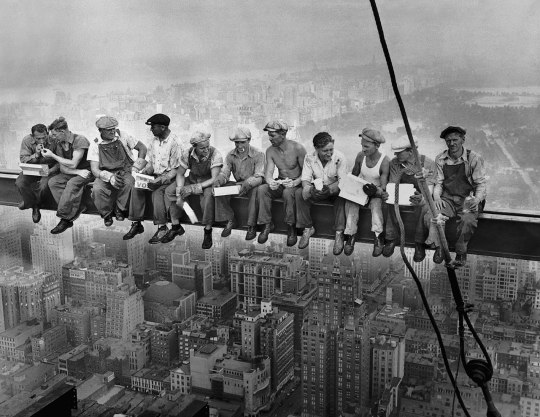
The photo appeared the first in the Sunday photo supplement of the New York Herald Tribune on October 2, 1932.
The photograph was taken on September 20, 1932, on the 69th floor of the RCA Building during the last months of construction. According to archivists, the photograph was in fact prearranged. Although the photograph shows real ironworkers, it is believed that the moment was staged by Rockefeller Center to promote its new skyscraper.
Formerly attributed to "unknown", and often misattributed to Lewis Hine, it was credited to Charles C. Ebbets in 2003. Evidence confirming his authorship held in the Ebbets' Estate archives include original work orders showing invoices to Rockefeller Center for the time period surrounding the photo, letters of recommendation from his work at Rockefeller Center when the photo was taken, a copy of the original article from the NY Herald Tribune when the photo first appeared in 1932 in his own scrapbook of his work, photos from his office in NY taken in 1932 showing the image on a bulletin board display of his work, and a negative of him at work on the site that day.
The movie Men at Lunch traces some of the men to possible Irish origin, and the director reported in 2013 that he planned to follow up other claims from Swedish relatives. The film confirms the identities of two men: Joseph Eckner, third from the left, and Joe Curtis, third from the right, by cross referencing with other pictures taken the same day, on which they were named at the time. The first man from the right has been identified as Slovak worker Gustáv (Gusti) Popovič from the village of Vyšný Slavkov in the Levoča District. Popovič was originally a lumberjack and carpenter. In 1932 he sent his wife Mária (Mariška) a postcard with this photograph on which he wrote, "Don´t you worry, my dear Mariška, as you can see I'm still with bottle. Your Gusti."
Gustáv and Mária's joint grave in the Vyšný Slavkov cemetery is decorated with the picture.
#vavuskapakage#fresh off the boat#constance wu#randall park#hudson yang#history of art#art#tv show quote#tv show#american art#american photography#Whistler's Mother#james mcneill whistler#pop art#victorian art#andy warhol#marilyn monroe#Lunch atop a Skyscraper#Charles C. Ebbets#Charles Clyde Ebbets#american artist#artoftheday#painting#illustration#silkscreen printing#original photographers#photography#photoart#photooftheday
32 notes
·
View notes
Text

Gene Eliza Tierney (November 19, 1920 – November 6, 1991) was an American film and stage actress. Acclaimed as a great beauty, she became established as a leading lady. Tierney was best known for her portrayal of the title character in the film Laura (1944), and was nominated for an Academy Award for Best Actress for her performance as Ellen Berent Harland in Leave Her to Heaven (1945).
Tierney's other roles include Martha Strable Van Cleve in Heaven Can Wait (1943), Isabel Bradley Maturin in The Razor's Edge (1946), Lucy Muir in The Ghost and Mrs. Muir (1947), Ann Sutton in Whirlpool (1949), Maggie Carleton McNulty in The Mating Season (1951), and Anne Scott in The Left Hand of God (1955).
I Gene Eliza Tierney was born on November 19, 1920 in Brooklyn, New York, the daughter of Howard Sherwood Tierney and Belle Lavinia Taylor. She was named after a beloved uncle, who died young.[4][page needed] She had an elder brother, Howard Sherwood "Butch" Tierney Jr., and a younger sister, Patricia "Pat" Tierney. Their father was a successful insurance broker of Irish descent, their mother a former physical education instructor.[4][page needed]
Tierney was raised in Westport, Connecticut. She attended St. Margaret's School in Waterbury, Connecticut, and the Unquowa School in Fairfield. She published her first poem, entitled "Night", in the school magazine and wrote poetry occasionally throughout her life. Tierney played Jo in a student production of Little Women, based on the novel by Louisa May Alcott.
Tierney spent two years in Europe, attending Brillantmont International School in Lausanne, Switzerland, where she learned to speak fluent French. She returned to the US in 1938 and attended Miss Porter's School in Farmington, Connecticut. On a family trip to the West Coast, she visited Warner Bros. studios, where a cousin worked as a producer of historical short films. Director Anatole Litvak, taken by the 17-year-old's beauty, told Tierney that she should become an actress. Warner Bros. wanted to sign her to a contract, but her parents advised against it because of the relatively low salary; they also wanted her to take her position in society.
Tierney's society debut occurred on September 24, 1938, when she was 17 years old. page needed] Soon bored with society life, she decided to pursue an acting career. Her father said, "If Gene is to be an actress, it should be in the legitimate theatre." Tierney studied acting at a small Greenwich Village acting studio in New York with Yiddish and Broadway actor/director Benno Schneider. She became a protégée of Broadway producer-director George Abbott.
In Tierney's first role on Broadway, she carried a bucket of water across the stage in What a Life! (1938). A Variety magazine critic declared, "Miss Tierney is certainly the most beautiful water carrier I've ever seen!" She also worked as an understudy in The Primrose Path (1938).
The following year, she appeared in the role of Molly O'Day in the Broadway production Mrs. O'Brien Entertains (1939). The New York Times critic Brooks Atkinson wrote, "As an Irish maiden fresh from the old country, Gene Tierney in her first stage performance is very pretty and refreshingly modest." That same year, Tierney appeared as Peggy Carr in Ring Two (1939) to favorable reviews. Theater critic Richard Watts Jr. of the New York Herald Tribune wrote, "I see no reason why Miss Tierney should not have an interesting theatrical career – that is, if cinema does not kidnap her away."
Tierney's father set up a corporation, Belle-Tier, to fund and promote her acting career. Columbia Pictures signed her to a six-month contract in 1939. She met Howard Hughes, who tried unsuccessfully to seduce her. From a well-to-do family herself, she was not impressed by his wealth. Hughes eventually became a lifelong friend.
After a cameraman advised Tierney to lose a little weight, she wrote to Harper's Bazaar magazine for a diet, which she followed for the next 25 years. Tierney was initially offered the lead role in National Velvet, but production was delayed. page needed] When Columbia Pictures failed to find Tierney a project, she returned to Broadway and starred as Patricia Stanley to critical and commercial success in The Male Animal (1940). In The New York Times, Brooks Atkinson wrote, "Tierney blazes with animation in the best performance she has yet given". She was the toast of Broadway before her 20th birthday. The Male Animal was a hit, and Tierney was featured in Life magazine. She was also photographed by Harper's Bazaar, Vogue, and Collier's Weekly.
Two weeks after The Male Animal opened, Darryl F. Zanuck, the head of 20th Century Fox, was rumored to have been in the audience. During the performance, he told an assistant to note Tierney's name. Later that night, Zanuck dropped by the Stork Club, where he saw a young lady on the dance floor. He told his assistant, "Forget the girl from the play. See if you can sign that one." It was Tierney. At first, Zanuck did not think she was the actress he had seen. Tierney was quoted (after the fact), saying: "I always had several different 'looks', a quality that proved useful in my career."
Tierney signed with 20th Century-Fox[4][page needed] and her motion picture debut was in a supporting role as Eleanor Stone in Fritz Lang's western The Return of Frank James (1940), opposite Henry Fonda.
A small role as Barbara Hall followed in Hudson's Bay (1941) with Paul Muni and she co-starred as Ellie Mae Lester in John Ford's comedy Tobacco Road (also 1941), and played the title role in Belle Starr alongside co-star Randolph Scott, Zia in Sundown, and Victoria Charteris (Poppy Smith) in The Shanghai Gesture. She played Eve in Son of Fury: The Story of Benjamin Blake (1942), as well as the dual role of Susan Miller (Linda Worthington) in Rouben Mamoulian's screwball comedy Rings on Her Fingers, and roles as Kay Saunders in Thunder Birds, and Miss Young in China Girl (all 1942).
Receiving top billing in Ernst Lubitsch's comedy Heaven Can Wait (1943), as Martha Strable Van Cleve, signaled an upward turn in Tierney's career. Tierney recalled during the production of Heaven Can Wait:
Lubitsch was a tyrant on the set, the most demanding of directors. After one scene, which took from noon until five to get, I was almost in tears from listening to Lubitsch shout at me. The next day I sought him out, looked him in the eye, and said, 'Mr. Lubitsch, I'm willing to do my best but I just can't go on working on this picture if you're going to keep shouting at me.' 'I'm paid to shout at you', he bellowed. 'Yes', I said, 'and I'm paid to take it – but not enough.' After a tense pause, Lubitsch broke out laughing. From then on we got along famously.
Tierney starred in what became her best-remembered role: the title role in Otto Preminger's film noir Laura (1944), opposite Dana Andrews. After playing Tina Tomasino in A Bell for Adano (1945), she played the jealous, narcissistic femme fatale Ellen Berent Harland in Leave Her to Heaven (1945), adapted from a best selling novel by Ben Ames Williams. Appearing with Cornel Wilde, Tierney won an Academy Award nomination for Best Actress. This was 20th Century-Fox' most successful film of the 1940s. It was cited by director Martin Scorsese as one of his favorite films of all time, and he assessed Tierney as one of the most underrated actresses of the Golden Era.
Tierney then starred as Miranda Wells in Dragonwyck (1946), along with Walter Huston and Vincent Price. It was Joseph L. Mankiewicz' debut film as a director, In the same period, she starred as Isabel Bradley, opposite Tyrone Power, in The Razor's Edge (also 1946), an adaptation of W. Somerset Maugham's novel of the same name. Her performance was critically praised.
Tierney played Lucy Muir in Mankiewicz's The Ghost and Mrs. Muir (1947), opposite Rex Harrison. The following year, she co-starred again with Power, this time as Sara Farley in the successful screwball comedy That Wonderful Urge (1948). As the decade came to a close, Tierney reunited with Laura director Preminger to star as Ann Sutton in the classic film noir Whirlpool (1949), co-starring Richard Conte and José Ferrer. She appeared in two other film noirs: Jules Dassin's Night and the City, shot in London, and Otto Preminger's Where the Sidewalk Ends (both 1950), reunited with both Preminger and leading man Dana Andrews, who she appeared with in five movies total.
Tierney was loaned to Paramount Pictures, giving a comic turn as Maggie Carleton in Mitchell Leisen's ensemble farce, The Mating Season (1951), with John Lund, Thelma Ritter, and Miriam Hopkins. She gave a tender performance as Midge Sheridan in the Warner Bros. film, Close to My Heart (1951), with Ray Milland. The film is about a couple trying to adopt a child. Later in her career, she was reunited with Milland in Daughter of the Mind (1969).
After Tierney appeared opposite Rory Calhoun as Teresa in Way of a Gaucho (1952), her contract at 20th Century-Fox expired. That same year, she starred as Dorothy Bradford in Plymouth Adventure, opposite Spencer Tracy at MGM. She and Tracy had a brief affair during this time.[10] Tierney played Marya Lamarkina opposite Clark Gable in Never Let Me Go (1953), filmed in England.
In the course of the 1940s, she reached a pinnacle of fame as a beautiful leading lady, on a par with "fellow sirens Rita Hayworth, Lana Turner and Ava Gardner". She was "called the most beautiful woman in movie history" and many of her movies in the 1940s became classic films.
Tierney remained in Europe to play Kay Barlow in United Artists' Personal Affair (1953). While in Europe, she began a romance with Prince Aly Khan, but their marriage plans met with fierce opposition from his father Aga Khan III. Early in 1953, Tierney returned to the U.S. to co-star in the film noir Black Widow (1954) as Iris Denver, with Ginger Rogers and Van Heflin.
Tierney had reportedly started smoking after a screening of her first movie to lower her voice, because she felt, "I sound like an angry Minnie Mouse." She subsequently became a heavy smoker.
With difficult events in her personal life, Tierney struggled for years with episodes of manic depression. In 1943, she gave birth to a daughter, Daria, who was deaf and mentally disabled, the result of a fan breaking a rubella quarantine and infecting the pregnant Tierney while she volunteered at the Hollywood Canteen. In 1953, she suffered problems with concentration, which affected her film appearances. She dropped out of Mogambo and was replaced by Grace Kelly.[4][page needed] While playing Anne Scott in The Left Hand of God (1955), opposite Humphrey Bogart, Tierney became ill. Bogart's sister Frances (known as Pat) had suffered from mental illness, so he showed Tierney great sympathy, feeding her lines during the production and encouraging her to seek help.
Tierney consulted a psychiatrist and was admitted to Harkness Pavilion in New York. Later, she went to the Institute of Living in Hartford, Connecticut. After some 27 shock treatments, intended to alleviate severe depression, Tierney fled the facility, but was caught and returned. She later became an outspoken opponent of shock treatment therapy, claiming it had destroyed significant portions of her memory.
In late December 1957, Tierney, from her mother's apartment in Manhattan, stepped onto a ledge 14 stories above ground and remained for about 20 minutes in what was considered a suicide attempt. Police were called, and afterwards Tierney's family arranged for her to be admitted to the Menninger Clinic in Topeka, Kansas. The following year, after treatment for depression, she was discharged. Afterwards, she worked as a sales girl in a local dress shop with hopes of integrating back into society, but she was recognized by a customer, resulting in sensational newspaper headlines.
Later in 1958, 20th Century-Fox offered Tierney a lead role in Holiday for Lovers (1959), but the stress upon her proved too great, so only days into production, she dropped out of the film and returned to Menninger for a time.
Tierney made a screen comeback in Advise and Consent (1962), co-starring with Franchot Tone and reuniting with director Otto Preminger.[4][page needed] Soon afterwards, she played Albertine Prine in Toys in the Attic (1963), based on the play by Lillian Hellman. This was followed by the international production of Las cuatro noches de la luna llena, (Four Nights of the Full Moon - 1963), in which she starred with Dan Dailey. She received critical praise overall for her performances.
Tierney's career as a solid character actress seemed to be back on track as she played Jane Barton in The Pleasure Seekers (1964), but then she suddenly retired. She returned to star in the television movie Daughter of the Mind (1969) with Don Murray and Ray Milland. Her final performance was in the TV miniseries Scruples (1980).
Tierney married two men: the first was Oleg Cassini, a costume and fashion designer, on June 1, 1941, with whom she eloped. She was 20 years old. Her parents opposed the marriage, as he was from a Russian-Italian family and born in France. She had two daughters, Antoinette Daria Cassini (October 15, 1943 – September 11, 2010) and Christina "Tina" Cassini (November 19, 1948 – March 31, 2015).
In June 1943, while pregnant with Daria, Tierney contracted rubella (German measles), likely from a fan ill with the disease. Antoinette Daria Cassini was born prematurely in Washington, DC, weighing three pounds, two ounces (1.42 kg) and requiring a total blood transfusion. The rubella caused congenital damage: Daria was deaf, partially blind with cataracts, and severely mentally disabled. She was institutionalized for much of her life. This entire incident was inspiration for a plot point in the 1962 Agatha Christie novel The Mirror Crack'd from Side to Side.
It is claimed that she had an affair with Mohammad Reza Shah of Iran during the late 1940s.
Tierney's friend Howard Hughes paid for Daria's medical expenses, ensuring the girl received the best care. Tierney never forgot his acts of kindness. Daria Cassini died in 2010, at the age of 66.
Tierney and Cassini separated October 20, 1946, and entered into a property settlement agreement on November 10. Periodicals during this period record Tierney with Charles K. Feldman, including articles related to her "twosoming" with Feldman, her "current best beau". The divorce was to be finalized in March 1948, but they reconciled before then.
During their separation, Tierney met John F. Kennedy, a young World War II veteran, who was visiting the set of Dragonwyck in 1946. They began a romance that she ended the following year after Kennedy told her he could never marry her because of his political ambitions. In 1960, Tierney sent Kennedy a note of congratulations on his victory in the presidential election. During this time, newspapers documented Tierney's other romantic relationships, including Kirk Douglas.
While filming for Personal Affair in Europe, she began a romance with Prince Aly Khan. They became engaged in 1952, while Khan was going through a divorce from Rita Hayworth. Their marriage plans, however, met with fierce opposition from his father, Aga Khan III.
Cassini later bequeathed $500,000 in trust to Daria and $1,000,000 to Christina. Cassini and Tierney remained friends until her death in November 1991.
In 1958, Tierney met Texas oil baron W. Howard Lee, who had been married to actress Hedy Lamarr since 1953. Lee and Lamarr divorced in 1960 after a long battle over alimony, then Lee and Tierney married in Aspen, Colorado, on July 11, 1960. They lived quietly in Houston, Texas, and Delray Beach, Florida until his death in 1981.
Despite her self-imposed exile in Texas, Tierney received work offers from Hollywood, prompting her to a comeback. She appeared in a November 1960 broadcast of General Electric Theater, during which time she discovered that she was pregnant. Shortly after, 20th Century Fox announced Tierney would play the lead role in Return to Peyton Place, but she withdrew from the production after suffering a miscarriage.
Tierney's autobiography, Self-Portrait, in which she candidly discusses her life, career, and mental illness, was published in 1979.
Tierney's second husband, W. Howard Lee, died on February 17, 1981 after a long illness.[24]
In 1986, Tierney was honored alongside actor Gregory Peck with the first Donostia Lifetime Achievement Award at the San Sebastian Film Festival in Spain.
Tierney has a star on the Hollywood Walk of Fame at 6125 Hollywood Boulevard.
Tierney died of emphysema on November 6, 1991, in Houston, thirteen days before her 71st birthday. She is interred in Glenwood Cemetery in Houston.
Certain documents of Tierney's film-related material, personal papers, letters, etc., are held in the Wesleyan University Cinema Archives, though her papers are closed to the public.
21 notes
·
View notes
Text

Female war correspondents during World War II. Summer-Autumn 1944 (Left to right):
Ruth Cowan, Associated Press
Sonia Tomara, New York Herald Tribune
Rosette Hargrove, Newspaper Enterprise Association
Betty Knox, London Evening Standard
Iris Carpenter, Boston Globe
Erika Mann, Liberty magazine.
#Ruth Cowan#Sonia Tomara#correspondent#correspondents#journalist#women journalists#female journalist#Rosette Hargrove#Betty Knox#Iris Carpenter#Erika Mann
1 note
·
View note
Photo


The Thief of Bagdad (1924). dir. Raoul Walsh
The New York Herald Tribune proclaimed The Thief of Bagdad “the greatest thing that ever has been put on the screen!” Photoplay magazine rhapsodized: “Here is magic. Here is beauty. Here is the answer to the cynics who give the motion picture no place in the family arts … It is a work of rare genius ….” Robert E. Sherwood, future playwright and Fairbanks collaborator, wrote in Life magazine, “Fairbanks has gone far beyond the mere bounds of possibility; he has performed the superhuman feat of making his magic seem probable.”
#the thief of bagdad#raoul walsh#film#douglas fairbanks#julanne johnston#1920s#old hollywood#silent era
21 notes
·
View notes
Text
Quotes to inspire your own non-fiction writing

Here are some quotes from the third edition of On Writing Well by William Zinsser - a writer, editor, newspaperman, teacher, and author whose book was published in 1985. Zinsser worked for the New York Herald Tribune, wrote a column for Life magazine, and was a contributor to The New Yorker and other leading magazines.
“Writing is hard work. A clear sentence is no accident.” (“Simplicity”, p. 12)

“Be grateful for everything you can throw away.” (“Clutter,” p. 18)
“Writing is an act of ego and you might as well admit it. Use its energy to keep yourself going.” (“Style,” p. 25)
“Most nonfiction writers will do well to cling to the ropes of simplicity and clarity.” (“Write as Well as You Can,” p. 233)

“You must take an obsessive pride in the smallest details of your craft.”(“Write as Well as You Can,” p. 233)
For more inspirational content, check out www.mediazide.com.
1 note
·
View note
Text
The Long, Sad Death of the NYC Newsstand
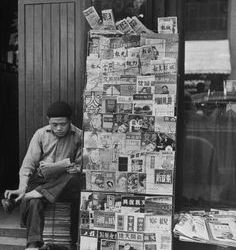
Up until 2003, New York’s newsstands—those charmingly ramshackle wood-and-aluminum sidewalk constructs where scurrying commuters could grab a morning paper, a pack of smokes and the new issue of Leg Show on their way to the train—were all privately owned and operated by the scruffy characters who inhabited them. All a would-be news dealer had to do was fill out some forms, give the city a check for $1000, and in return they’d receive a two-year license. The license gave them rights to a location, but the costs of building the stand and operating the business was the responsibility of the new owner. That said, within zoning regulations, they could do what they wanted with their stand: paint it whatever garish color they liked, design it after the Taj Mahal, sell Ju-Ju powders along with The Irish Times and racing forms, and keep all the profits at the end of the day. They even, under certain circumstances, maintained the right to sell the newsstand and the license if they so chose. All that changed in 2003, but I’ll get back to that. It was hardly the beginning or the end of the city’s war on newsstands, a war which began soon after newsstands became such an iconic part of New York’s sidewalk landscape.
If we can accept Hollywood films as providing an accurate historical record, ad-hoc open-fronted newsstands had been a familiar and welcome part of daily life in New York since at least the first half of the nineteenth century. Most, again if we accept the Hollywood myth, were owned and operated by gruff but lovable cigar-chomping midgets or preternaturally wise blindos, colorful outsiders who inevitably knew far more about what was going on than what was reported in any of the periodicals they sold. Newsstand operators were the eyes and ears of the community, knew everyone, and acted as invaluable sources for cops and reporters in search of tips. Especially the blind ones.
We may have no choice but to accept the mainstream studio version, as historians seem flummoxed when it comes to pinpointing exactly when or where the first of New York’s newsstands appeared. All they can say for certain is that the hundreds of newsstands that dotted street corners and subway stations across the five boroughs were modeled in function if not form after similar news outlets which had been commonplace in England, France and Italy since the late eighteenth century. But there is at least a small kernel of truth to the mainstream studio version, if you’ll allow me an aside.
For over half a century, thanks to a program spearheaded by the NY State Commission for the Blind, a handful of the city’s newsstands—in City Hall, the King’s County Courthouse, and a select few subway stations—were designated to be run by blind operators exclusively. It seemed a more humane alternative to forcing the blind to sell pencils out of a tin cup. Whether or not these blind news vendors acted as infallible informants for newspapermen and the cops is unknown, but the program was an extremely popular and desirable one within the blind community, allowing those lucky enough to take over a newsstand to earn a living wage. Unfortunately the program was so popular that in the early ’90s I was told the waiting list was so long it would likely be twenty years or more before I was set up in my own operation. Now I have to imagine the wait is even longer, but more about that later, too.
By the late nineteenth century New York’s stand alone sidewalk newsstands had evolved into their iconic form: a shack, usually painted green, constructed of wood and metal, with a low shelf along the front to hold bundles of newspapers, another shelf above that to hold candy and other snacks, and open window through which the proprietor conducted business, with cigarettes and magazines displayed on the wall behind him.
As beloved and essential as the newsstands became among New Yorkers, they’d always had a rough go of it. During the newspaper wars of the 1880s and ’90s, when competing papers quite literally battled each other in pursuit of higher circulation numbers, it was often the newsstand operators who caught the brunt of the violence. If, thanks to personal political leanings or, more often, a little monthly handout, a news vendor opted to carry The World, say, and not The Herald-Tribune, he might find himself beaten bloody by Herald-Tribune deliverymen, his newsstand torched or bombed. A similar fate often also awaited those vendors who, out of respect for the First Amendment or a sense of egalitarianism, refused to play favorites by foolishly carrying all the city dailies.
Not long after the Newspaper Wars were resolved, the city took up the fight to make your average news vendor’s life miserable. In 1911, the city prepared legislation to get rid of newsstands altogether by revoking the owners’ licenses, arguing the stands blocked foot traffic. Newsstand operators banded together against the threat. In a public hearing, the Newsdealers Association President William Merican told members of city council, “Why, there are some men who cannot eat their breakfast without a newspaper. Think of the women in the crush of the subway and elevated. They are exposed to every kind of indignity and hardship. They buy newspapers to make them forget their misery. If the public cannot get their newspapers on the street, they will find the inconvenience intolerable.”
The mayor was swayed by the argument, and the proposed legislation was shelved, at least for a little while.
A decade later in the early Twenties the NY Times took up the fight to do something about what the city’s wealthy and powerful considered an eyesore. Citing the Municipal Art Society’s plans to design polished modernist newsstands that would blend organically with their surroundings, the Times wrote “Why should the sidewalk news stand remain in the architectural class of the squatter’s shanty and the chicken coop? Why shouldn’t it be beautiful or at least not offensive to the eye?”
What the Times clearly didn’t realize was that by then, and over the decades to come, news vendors were not only designing and decorating their stands to reflect the personalities of the owner and the community, but selling things catering specifically to the neighborhood. You can’t get more organic than that. A Financial District newsstand served a different clientele and purpose than one in the East Village, and one in Park Slope served a different clientele and purpose than one in Flushing. (Well, at least that was the case in the twentieth century, even if it isn’t anymore.)
A number of newsstands, especially in the outer boroughs, evolved into mini community centers, with folks from the neighborhood hanging out with the owner to catch up with the news and each other. Some vendors gave their stands unique paint jobs (in some instances adorning the sides with murals), others hung Chinese lanterns or installed awnings, while still others abandoned the standard shack format altogether for more architecturally interesting designs. Despite the general perception, virtually no two stands were identical.
Ignoring (or more likely unaware of) this, the city pushed ahead with their efforts to beautify the stands,. In the ’50s and ’60s the city began once again drafting plans and sponsoring contests with an eye toward replacing the glorified chicken coops with sleek and uniform metal and glass designs, but none of their efforts went anywhere. Beyond that, there were the seemingly bi-annual efforts mounted by city council and various morality watchdog groups to ban the sale of porn. Every time the city pushed on this issue, the newsstand operators once again pushed back, arguing that porn sales represented a huge percentage of their annual profits, and by taking that away, the city would be putting them out of business.
In 1987, Hudson News was founded. Hudson News was an international chain operation, essentially the Taco Bell of storefront newsstands, whose slick and jazzy neon logo quickly became a familiar sight in airports and train stations across the country. It seems Hudson News represented exactly what New York officials had been looking for since the turn of the century. After grabbing spots in Penn Station, Grand Central, JFK and LaGuardia in the early ’90s, Hudson News and the city both took aim at the newsstands in the subway. Suddenly it was argued that the newsstands which had been there forever were not only obstructions to commuter movement, but blocked police sight lines on the platforms as well, preventing them from stopping crime. It was an insane argument no one had brought up before, but it worked. Before long, a number of the old subway newsstands were replaced with stand-alone Hudson News kiosks. The ironic thing of course, is that the Hudson News stands were much bigger and brighter, presenting even more of an obstacle to commuters and cops alike. But they were much nicer looking and covered with neon piping, so that was okay.
For the moment anyway, the sidewalk newsstands were safe.
Then along came Rudy Giuliani, The new Law and Order mayor who made his own bid to get rid of New York’s newsstands. Along with his efforts to scrub the city clean of porn, Giuliani argued the newspapers sold at these stands sometimes blew away, adding to New York’s litter problem. The only solution, as part of his Quality of Life campaign, was to get rid of the newsstands altogether. Once again the vendors and their customers alike pushed back.
Although Giuiliani was able to clean up Times Square and Coney Island, by the time he left office those sloppy newsstands remained steadfast, and New Yorkers were still wandering knee-deep in scattered fluttering pages of The Financial Times and The Guardian.
It took his successor, Michael Bloomberg, to do what Giuliani couldn’t. Always with a mind toward the tidy and seemly and sterile, Bloomberg had long found the city’s newsstands an eyesore. In 2003 he signed what was called The Street Furniture Bill. As he put it, the aim of the bill was “to rationalize the streets of the city, where right now it's a hodgepodge of unattractive things.” The quote says a lot about Bloomberg, how he perceived New York, as well as how and why NYC turned into Des Moines.
With an eye toward faceless uniformity, the city cut a deal with the Spanish company Cemusa to design not only clean and pleasant newsstands, but matching public toilets and other bits of street furniture as well. Soon, it seemed, Bloomberg would have his dream, and wherever you went in New York, it would look just like every other part of New York.
Four years later, the city began seizing those ugly hodge-podge newsstands away from their longtime independent owners, people who had in some cases owned and operated their own newsstands for forty years or more, replacing them with identical steel and glass boxes decorated with enormous digital ads. In a blink, those faces you saw behind the newsstand windows were now mere employees, and all profits from those digital ads went straight to the Cemusa company.
By 2009, over 200 old newsstands had been removed, replaced by 300 sleek and shiny boxes with those goddamn digital ads all over them. But by then it was a moot point. With the internet killing off newspapers and magazines, and with everyone staring dead-eyed into phones instead of picking up a copy of the Daily News on the fly, newsstands themselves became all but irrelevant. As quickly as those slick and flashy boxes appeared, they began to vanish. Nowadays you’d be hard pressed to find a sidewalk newsstand anywhere in New York, though there are still a few in the subways and train stations, where Hudson News is still king.
In a final and ironic insult, in 2013, long after most of New York’s newsstands were nothing but a grubby and fading memory, every last one of them operated by Angelo Rossitto in a newsboys cap, the city spent an estimated $90,000 on a new newsstand design to replace the one which had been in the lobby of the Brooklyn criminal courts building for over forty years. As that had always been one of the stands set aside for blind operators, the primary goal of the new design was that it be blind accessible.
Once completed, it was discovered this fancy new newsstand, which had been designed with absolutely no input from a single blindo, let alone the one who would be working there, was not in the least accessible, and so had to be scrapped. The city then dumped even more money into yet another design, but by then it was too late. No matter how popular and valuable that State Commission for the Blind program was, the New York newsstand had gone the way of the dodo, making the hubbub over the blind-friendly design for the Brooklyn courthouse irrelevant.
I can’t help but suspect the city’s alleged good-hearted move to do something decent for the disabled community (one member of it, anyway) in fact cloaked a deeply cynical effort to deal out one last fatal blow in the century-old effort to do away with newsstands altogether, making the city that much less interesting.
Well, they got what they wanted, though aesthetics aside, the more conspiratorial sections of my brain still wonders what was really behind the push.

.by Jim Knipfel
3 notes
·
View notes